Best Evergreen Plants For A Privacy Hedge
Does your yard need some privacy from your neighbors? Then this list of the best evergreen plants for a privacy hedge is for you. Whether you live in a cold hardiness zone or a warm one, want fast-growing privacy shrubs or slow, need bushes that are narrow or wide, or have a yard with lots of sun or shade, there is sure to be a perfect option for your landscape.
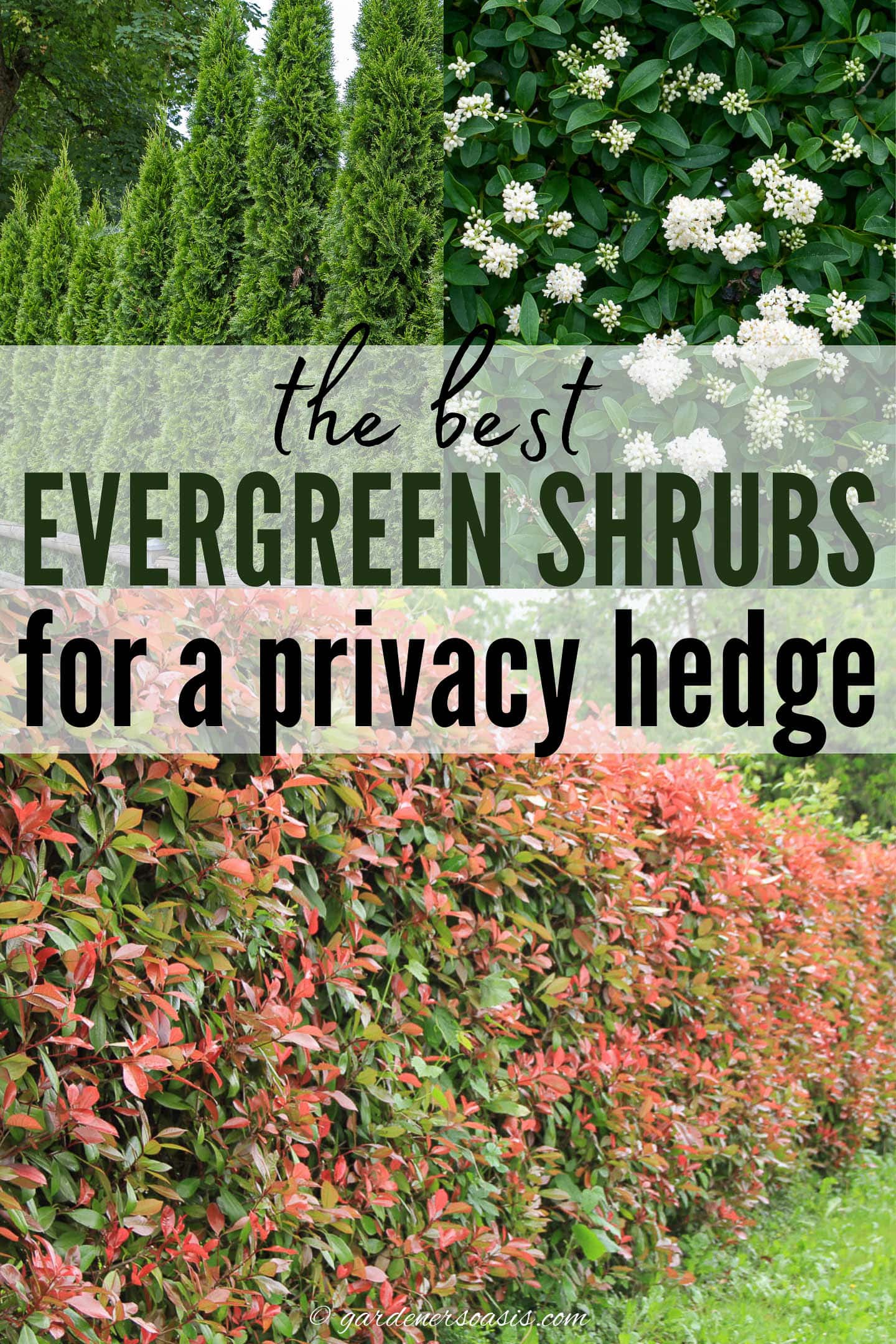
If you live in a home with a standard city-sized lot like I do, then you probably feel like your neighbors are watching your every move when you're out in your backyard.
Which just isn't very relaxing…and we're going to fix that.
Planting along the edges of your property is a great way to give yourself a living privacy fence while adding to the beauty of your backyard.
The best plants for fence line privacy are tall-growing shrubs with dense evergreen foliage that can shield you from prying eyes all year round.
In this guide, I’m covering the best evergreen hedges for privacy including varieties that will thrive in both shade and sun, as well as colder and warmer climates.
So you should be able to find a few that will work in your yard.
1 | Arborvitae
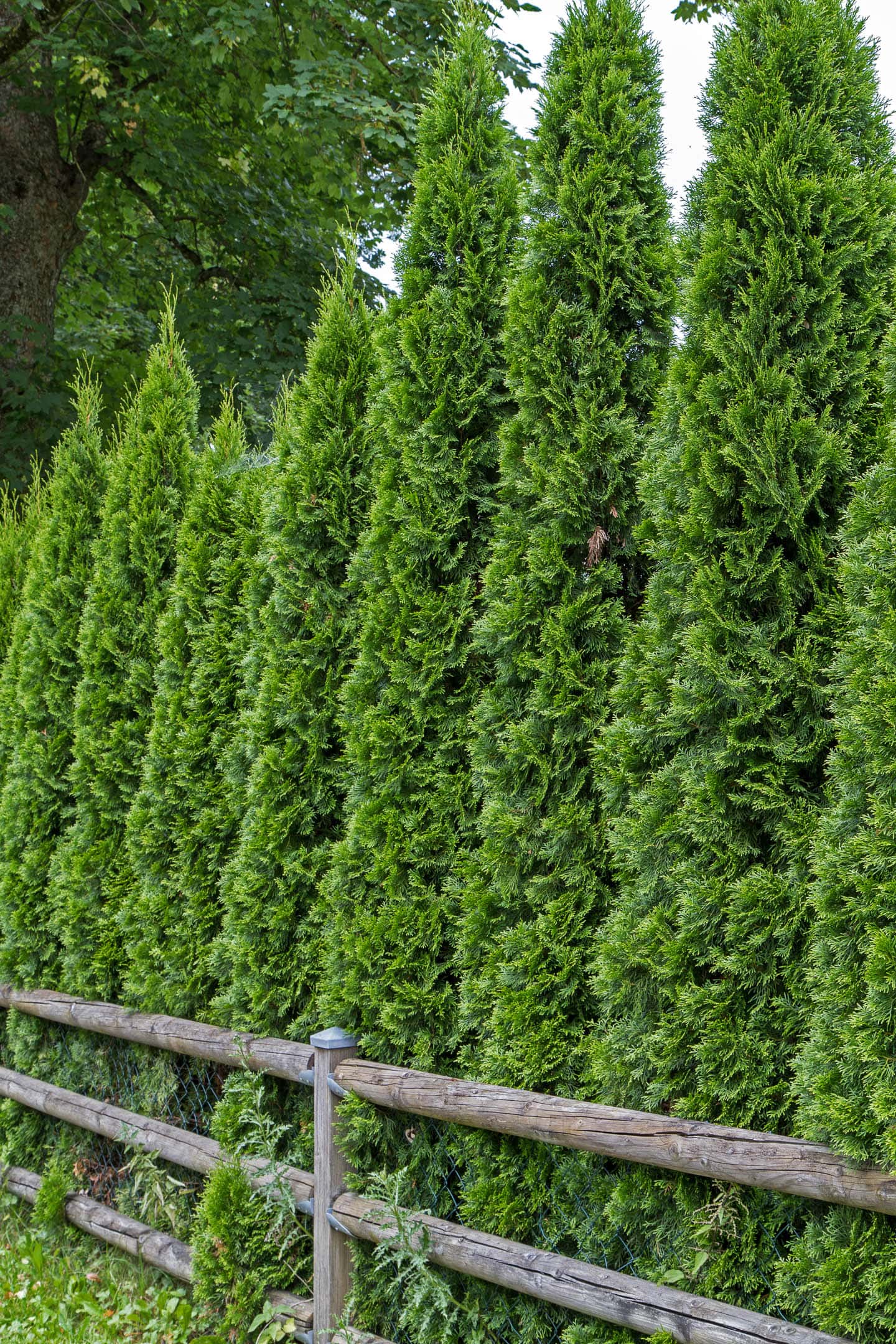
Botanical Name: Thuja
Zones: 3 to 8
Light Requirements: Full sun to partial shade
Bloom Time: Foliage only
Height: 12 to 50 feet tall (depending on the variety)
Spread: 3 to 15 feet wide
Growth Rate: 6 inches to 5 feet per year, full maturity in 4 to 20 years (depending on the variety)
Pest Resistance: Toxic to deer and other animals
Arborvitae are one of the most popular privacy hedges because they are so easy to grow, can grow quite tall and most tend to be columnar in shape. So they don't take up much room in your yard.
These evergreen trees form a dense hedge that is perfect for providing privacy from a busy street, or for lining the edge of a large property.
Arborvitae “Green Giant” (fast growing) and “Emerald Green” (slow growing) are two popular varieties known for their vibrant color.
2 | Canadian Hemlock
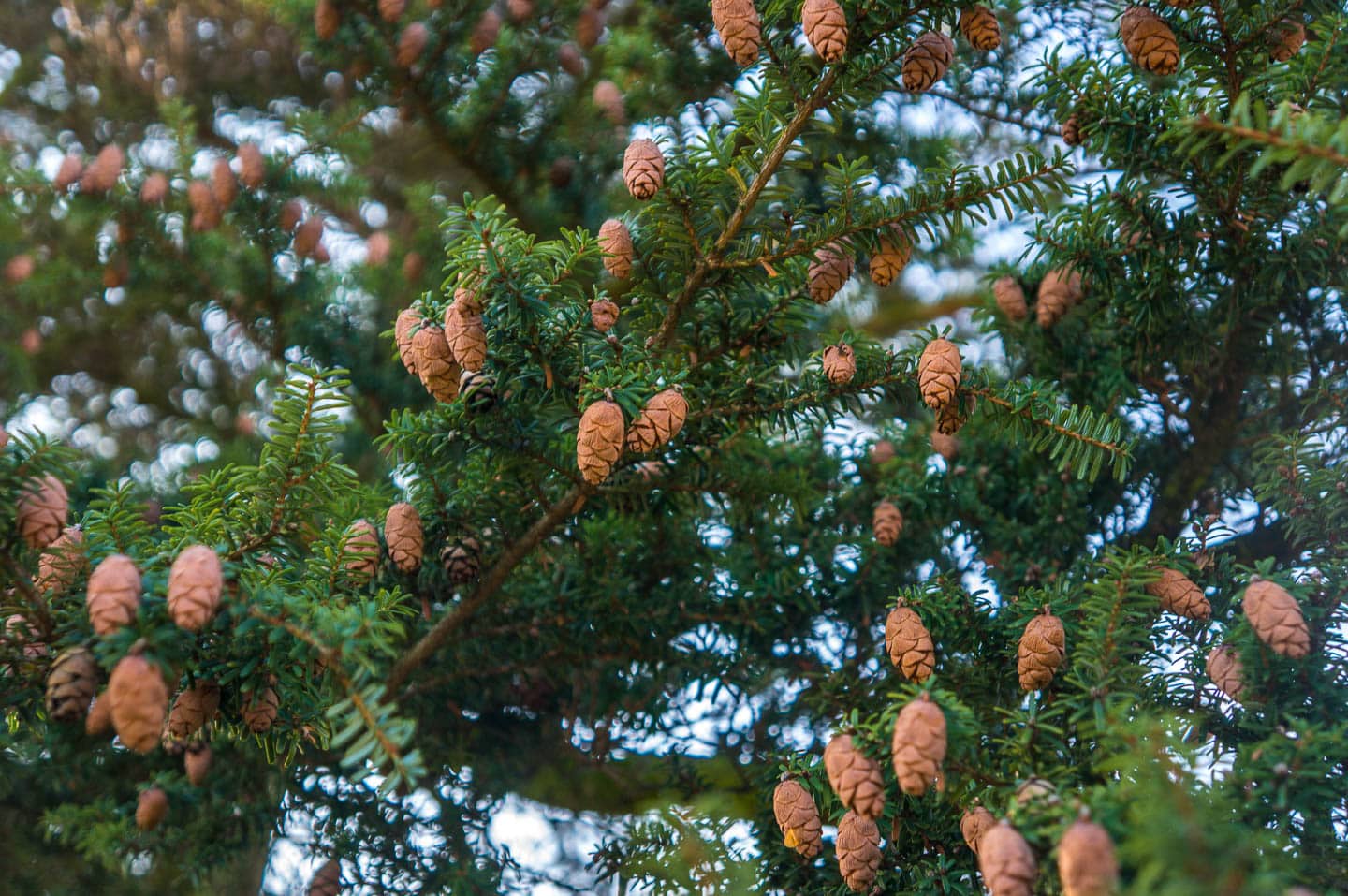
Botanical name: Tsuga canadensis
Zone: 3 to 8
Light: Full sun to full shade
Bloom Time: Spring
Bloom Color: Yellow
Height: 40 to 70 feet tall
Spread: 25 to 35 feet wide
Growth Rate: 1 to 2 feet per year; full maturity in 20 to 70 years
Pest Resistance: Resistant to most wildlife
The Canadian hemlock is an evergreen tree that is a native to North America.
It thrives in cool, moist and slightly acidic soil and can live for hundreds of years in the right location.
With its naturally pyramidal shape and slow growth rate, it does not require a lot of pruning, unless you want to keep them smaller than their natural size.
The needles of the Canadian hemlock are a deep green hue and quite soft in texture.
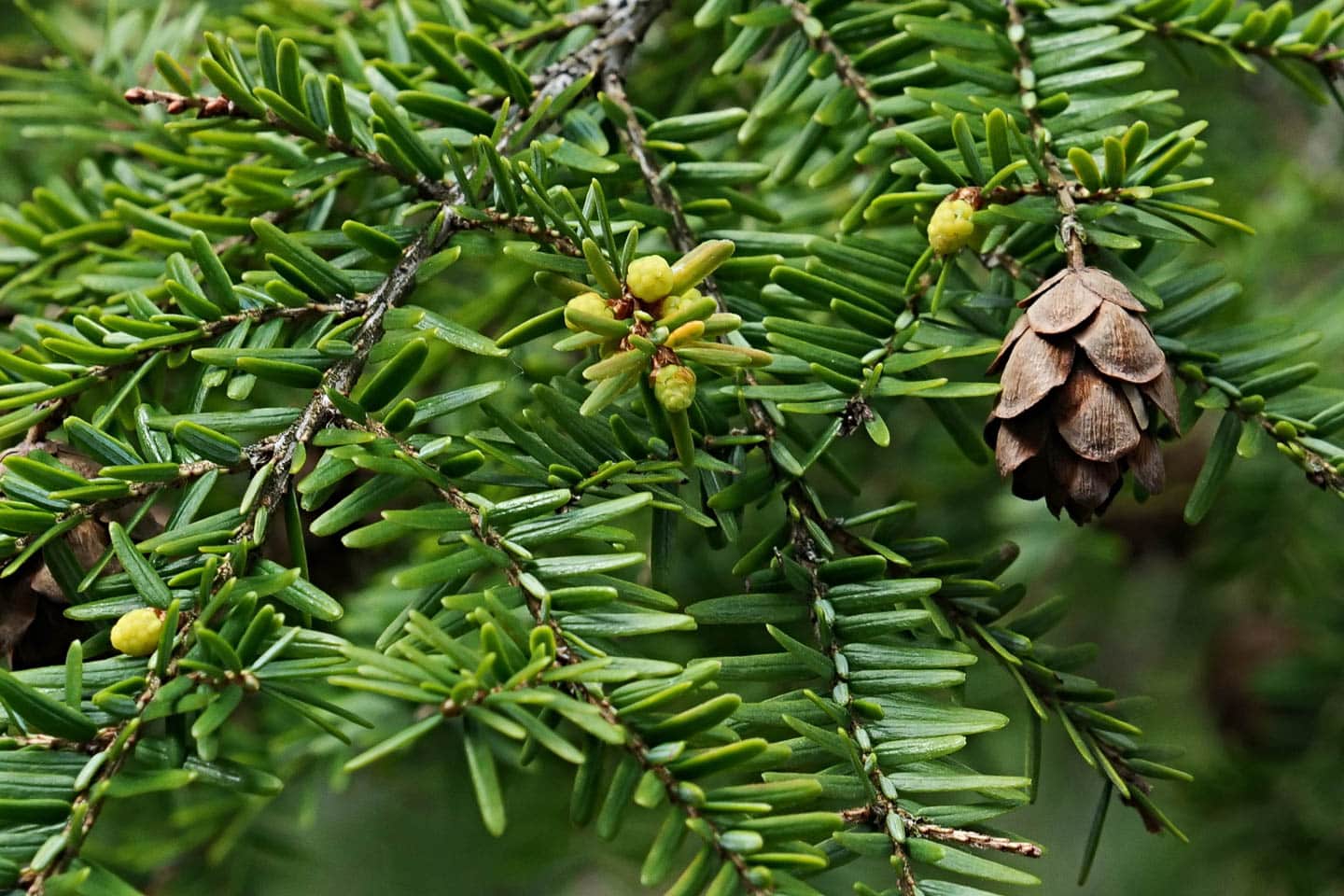
Once this evergreen is established, it will begin to produce both male and female flowers (that look like small globes) in the spring. After pollination, the male flowers will form pine cones that can be used for winter decorating.
3 | Hicks Yew
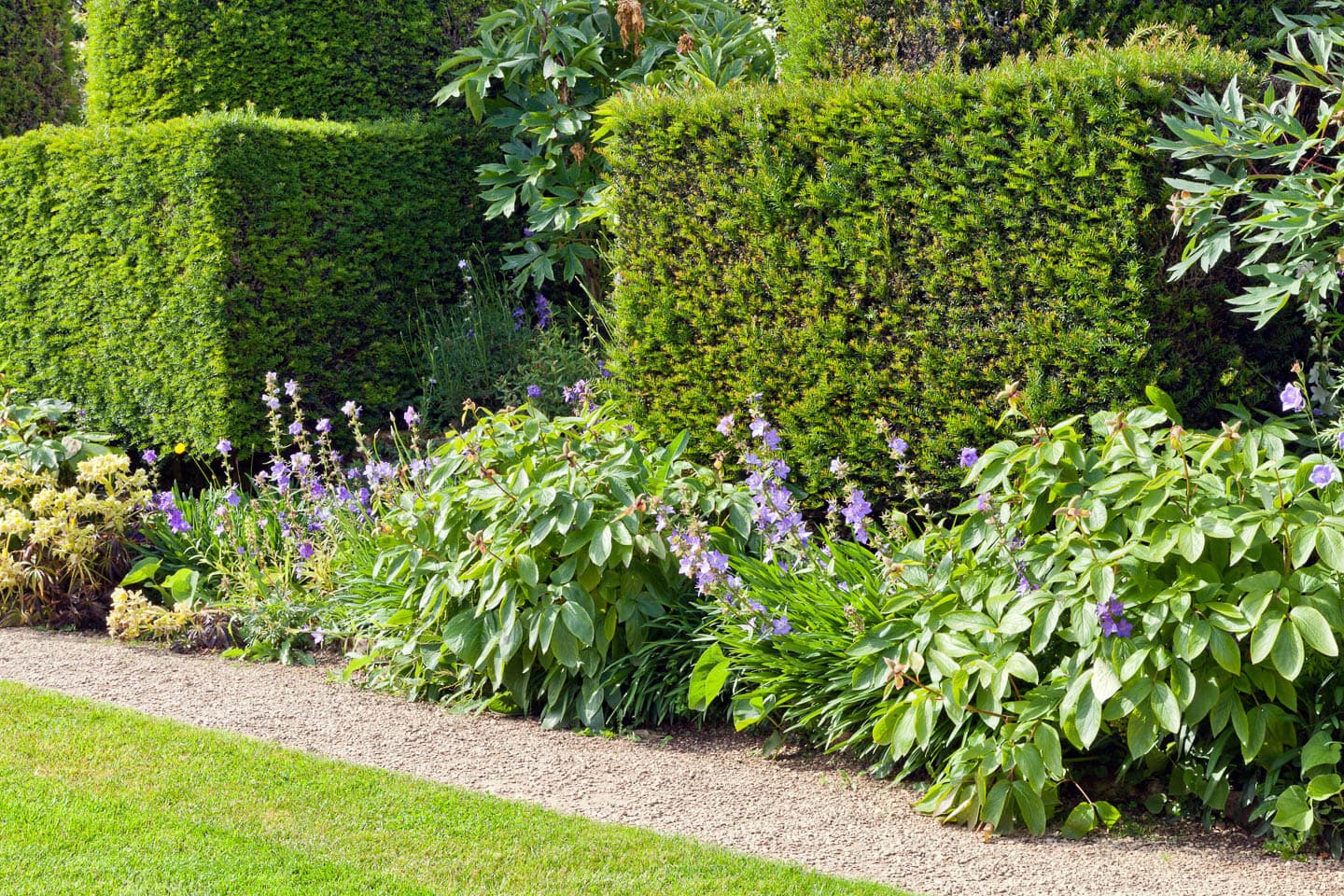
Botanical Name: Taxus x media ‘Hicksii'
Zones: 4 to 7
Light Requirements: Full sun to part shade
Bloom Time: Foliage only
Height: 8 to 12 feet tall
Spread: 3 to 4 feet wide
Growth Rate: Up to 12 inches each year, full maturity in 4 to 12 years
Pest Resistance: Resistant to deer and most other pests
Hicks Yew is an evergreen shrub that has a narrow, columnar shape with dense foliage that make the perfect privacy screen for small spaces.
It is very easy to grow in a wide range of soil types and can easily be pruned to whatever shape or size fits your garden.
And it makes a beautiful background for the other plants in your garden.
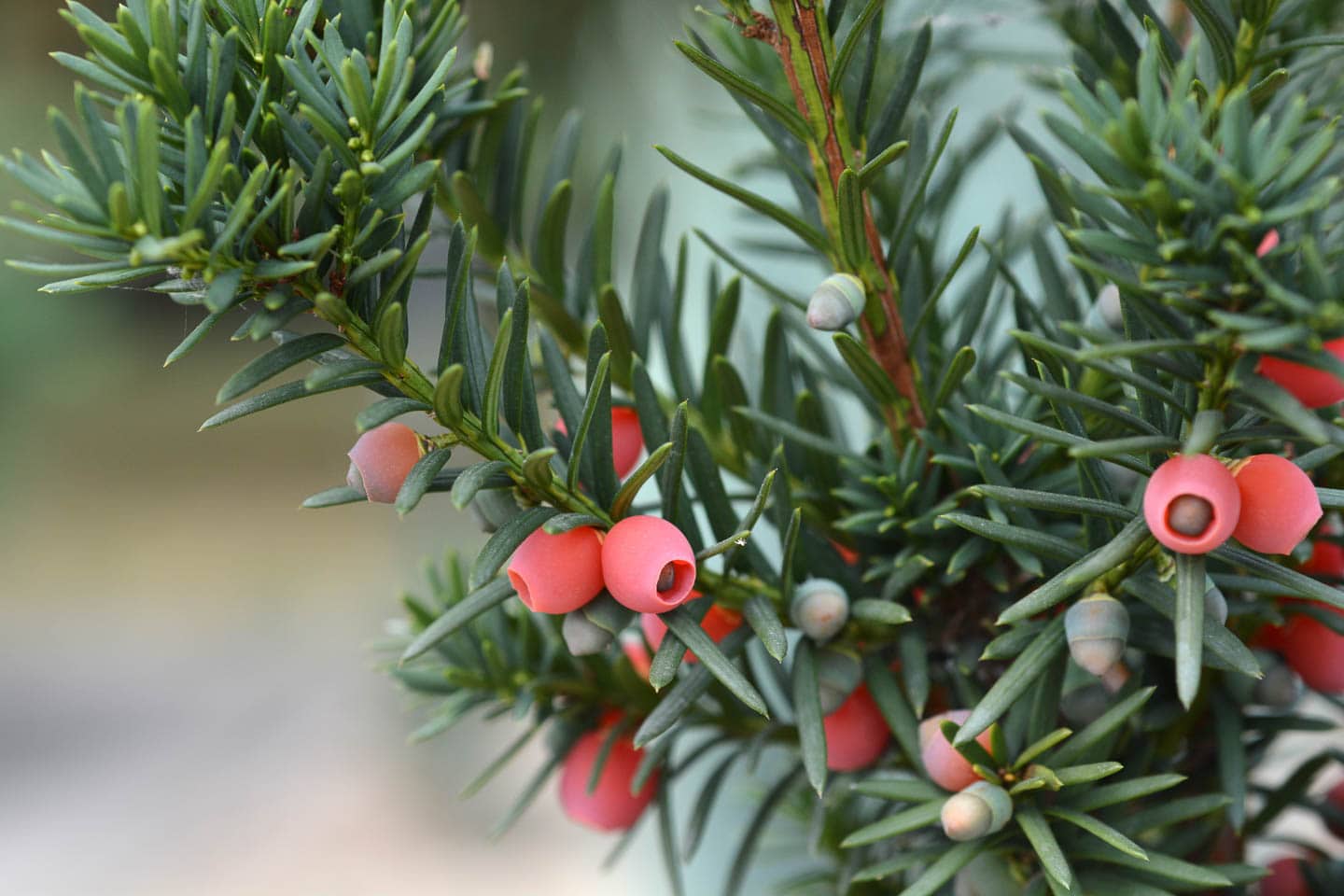
Once mature, the female Yew produces small round red berries which make it especially beautiful in the winter months.
4 | Privet
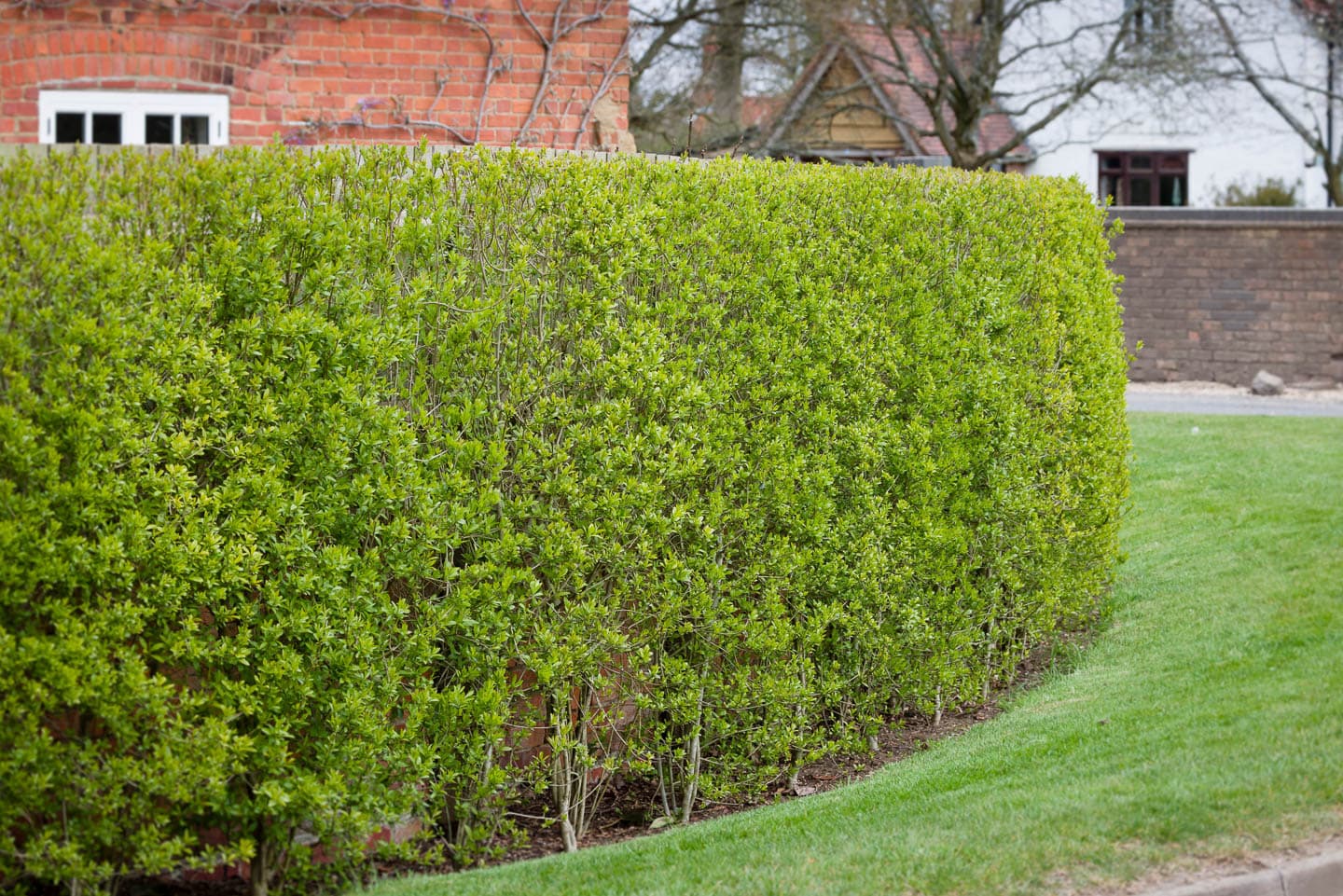
Botanical Name: Ligustrum
Zones: 3 to 11 (depending on the variety)
Light Requirements: Full sun to partial shade
Bloom Time: Summer
Bloom Color: White
Height: 4 to 15 feet tall
Spread: 4 to 10 feet wide
Growth Rate: Up to 3 feet each year, full maturity in 1 to 3 years
Pest Resistance: Toxic to people and most animals
Privet is an extremely popular choice for privacy hedges, probably due to its densely packed leaves, fast growth rate and easy to maintain nature.
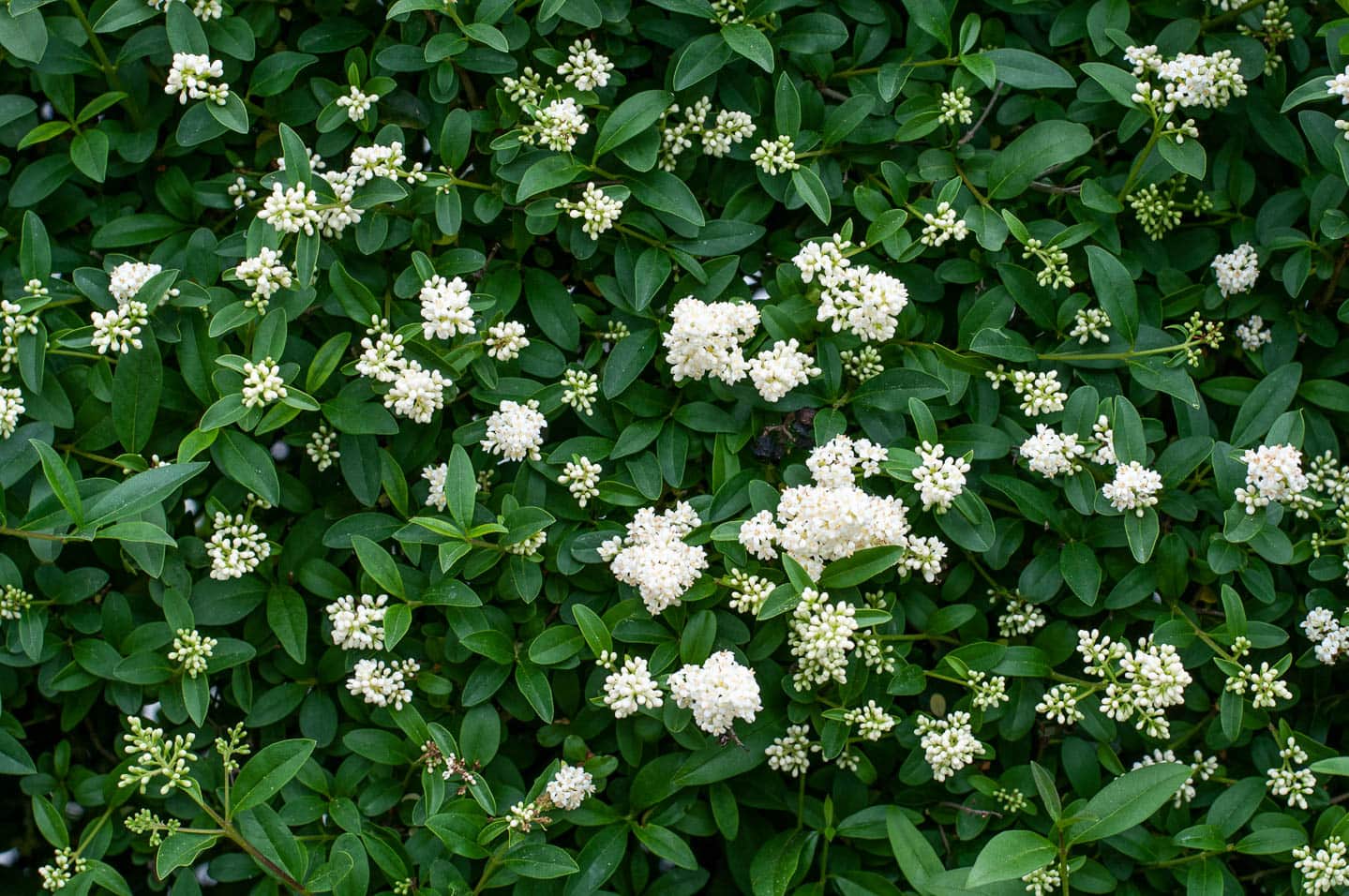
They produce white flowers in early summer followed by black berries in the fall that provide food for the birds in the colder months.
A common choice for topiaries, Privet shrubs can be shaped however you like to create dense walls, beautiful figures, and interesting geometric shapes.
There are many different Privet varieties that are tolerant of a wide range of temperatures so you're sure to find at least one that can be grown in your area.
5 | Boxwood
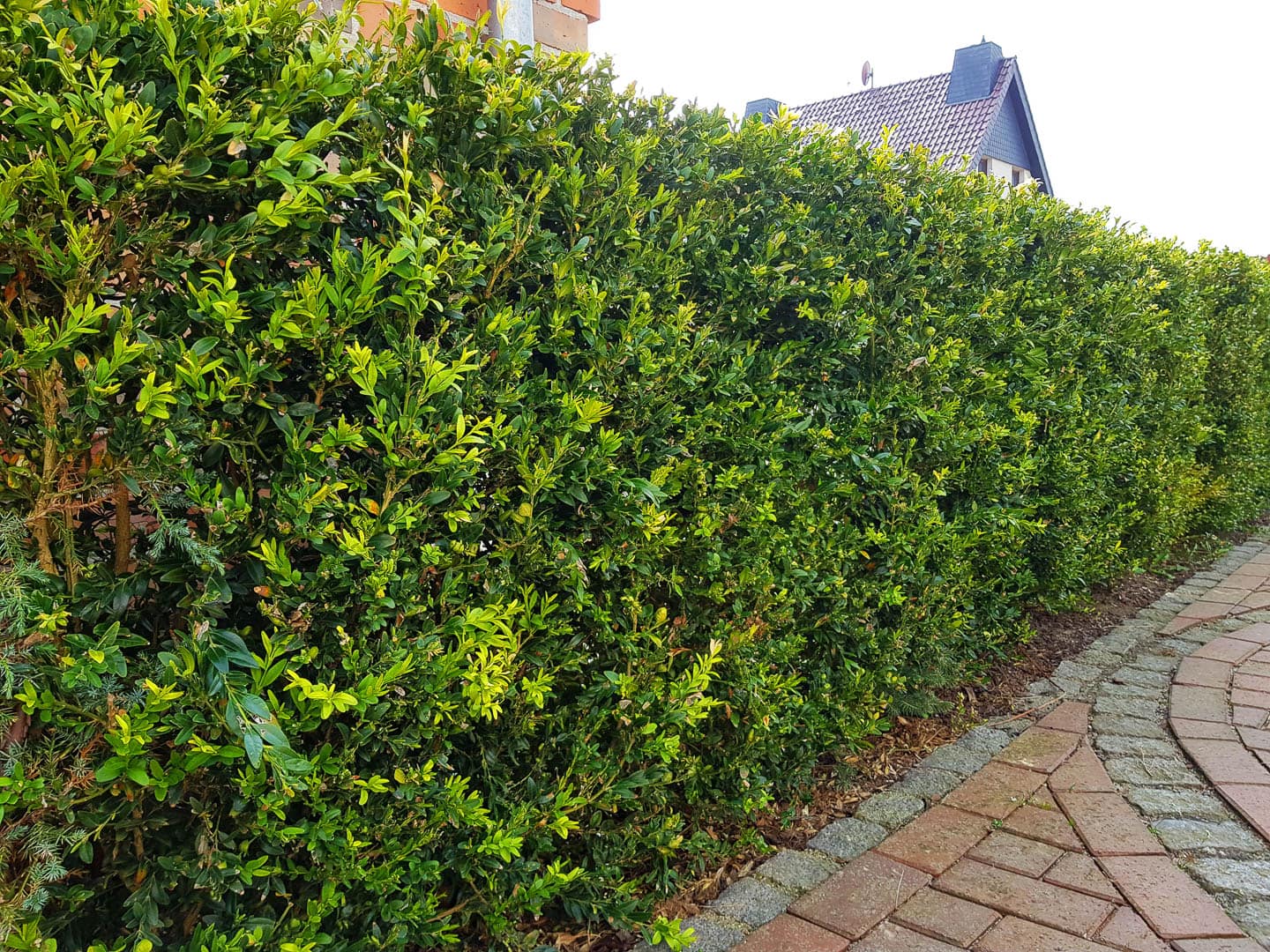
Botanical Name: Buxus
Zones: 4 to 9
Light Requirements: Full sun to full shade
Bloom Time: Spring
Bloom Color: White
Height: 1 to 20 feet tall
Spread: 2 to 8 feet wide
Growth Rate: 2 to 3 inches each year, full maturity in 15 to 25 years
Pest Resistance: Toxic to deer and other animals
Boxwood is a slow growing evergreen shrub that produces small glossy green leaves with a slightly waxy sheen.
Perfect for lining fences or for use as a stand-alone privacy hedge, Boxwood is a popular choice for gardeners seeking a super-dense option that is nearly impossible to look through.
It will even deter deer from entering your garden since they don't like to jump into spaces that they can't see. (You can find more ways to keep deer out of your garden HERE.)
Although it is easy to prune into shapes, this evergreen shrub is also beautiful when left natural.
Boxwoods grow very well in containers. So for a different variation of the standard privacy hedge, try planting it in large pots used to line the perimeter of your yard.
6 | Cherry Laurel
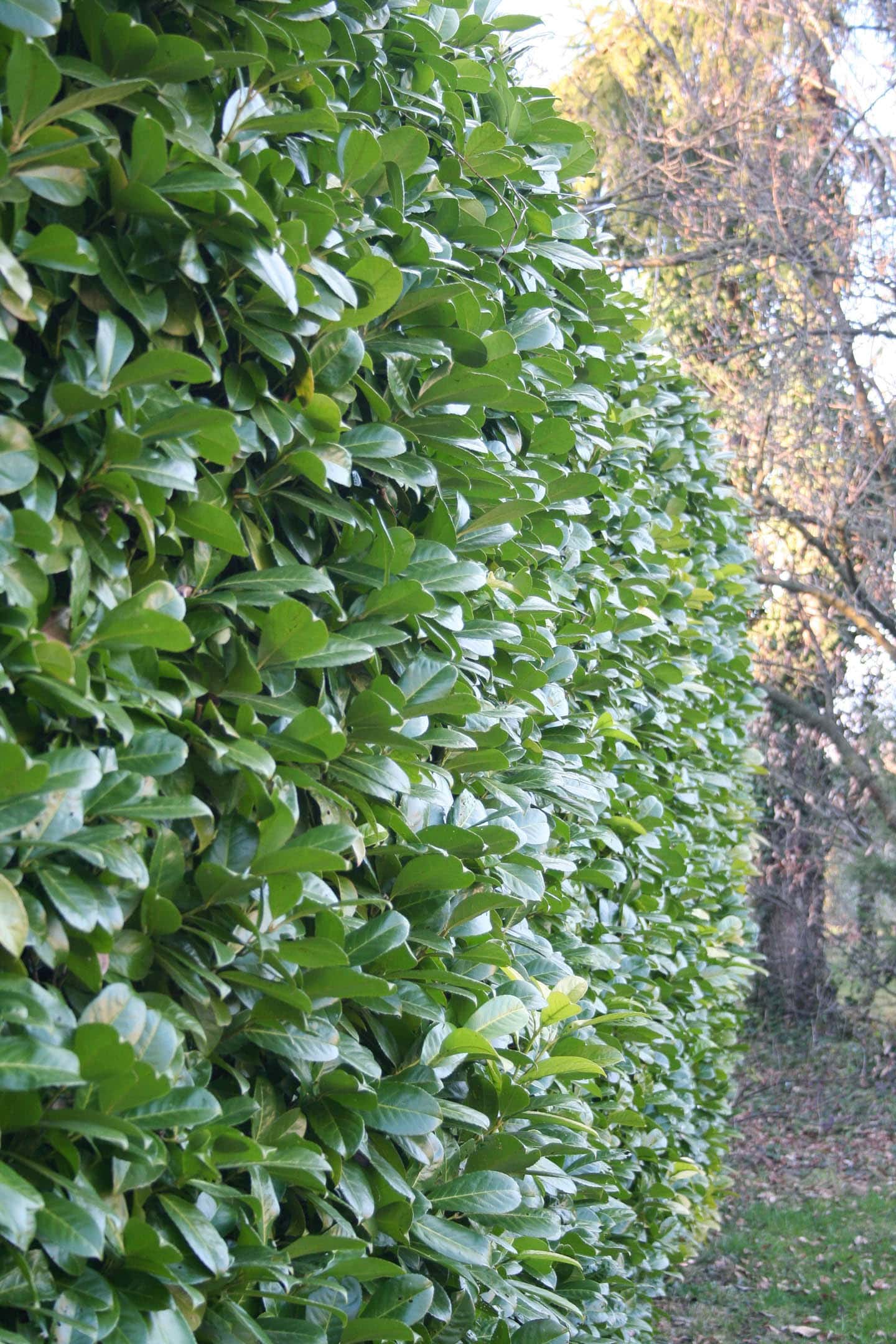
Botanical Name: Prunus laurocerasus
Zones: 4 to 9
Light Requirements: Full sun to full shade
Bloom Time: Spring
Bloom Color: White
Height: 30 feet tall
Spread: 15 feet wide
Growth Rate: 25 inches per year, full maturity in 10 to 15 years
Pest Resistance: Toxic to deer and other animals
Cherry (or English) Laurel is a versatile plant that can be pruned to be either a low-growing shrub or a taller tree.
Whether you like your laurels tall or short, this lovely evergreen variety makes an excellent privacy hedge.
It's tolerant of both full sun and full shade and is super easy to care for.
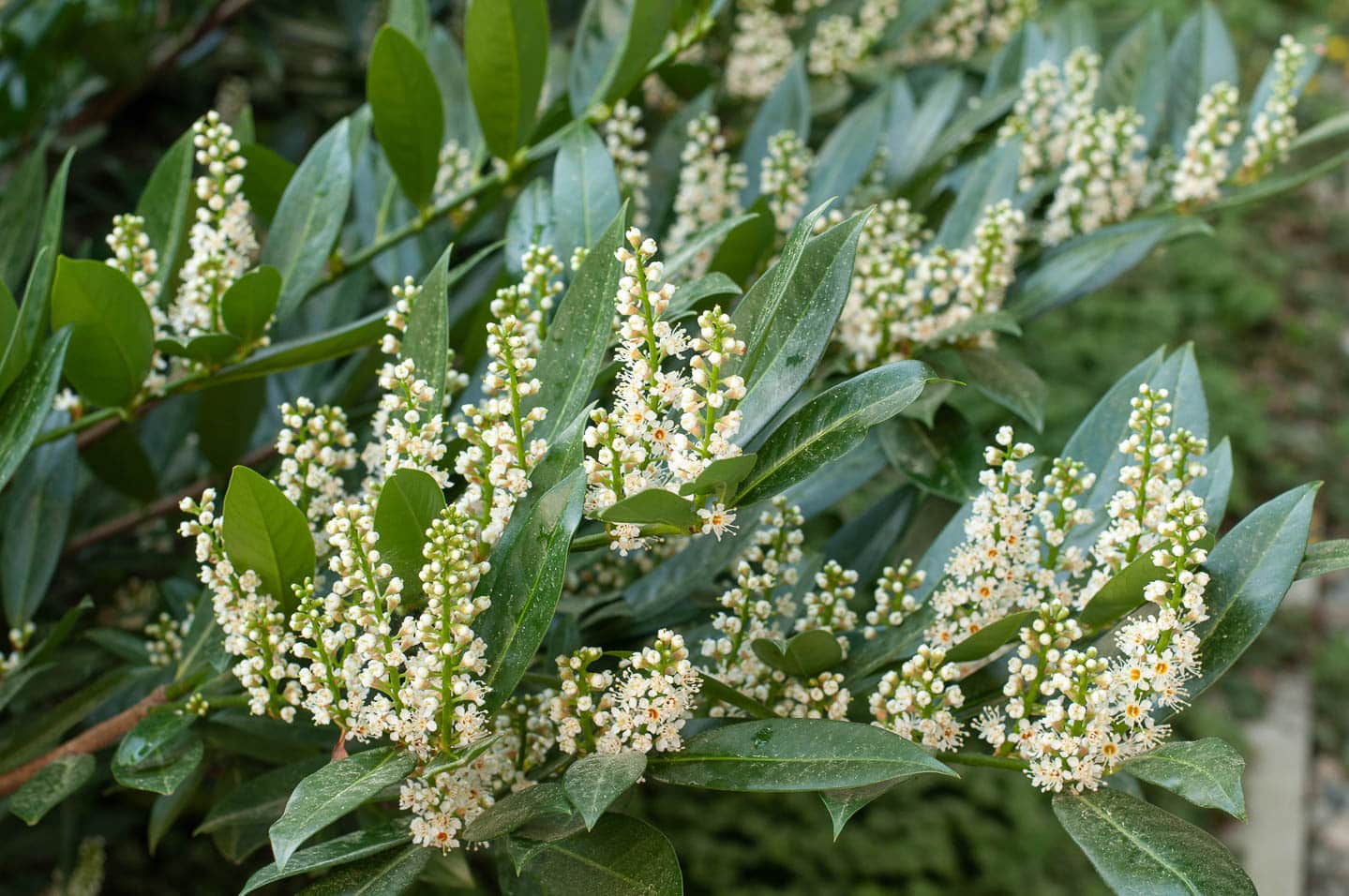
Cherry Laurel produces white flowers in spring that attract butterflies, bees and other pollinators.
These are followed by small cherry-like fruits that give this plant its name. And the birds love them!
7 | Firethorn
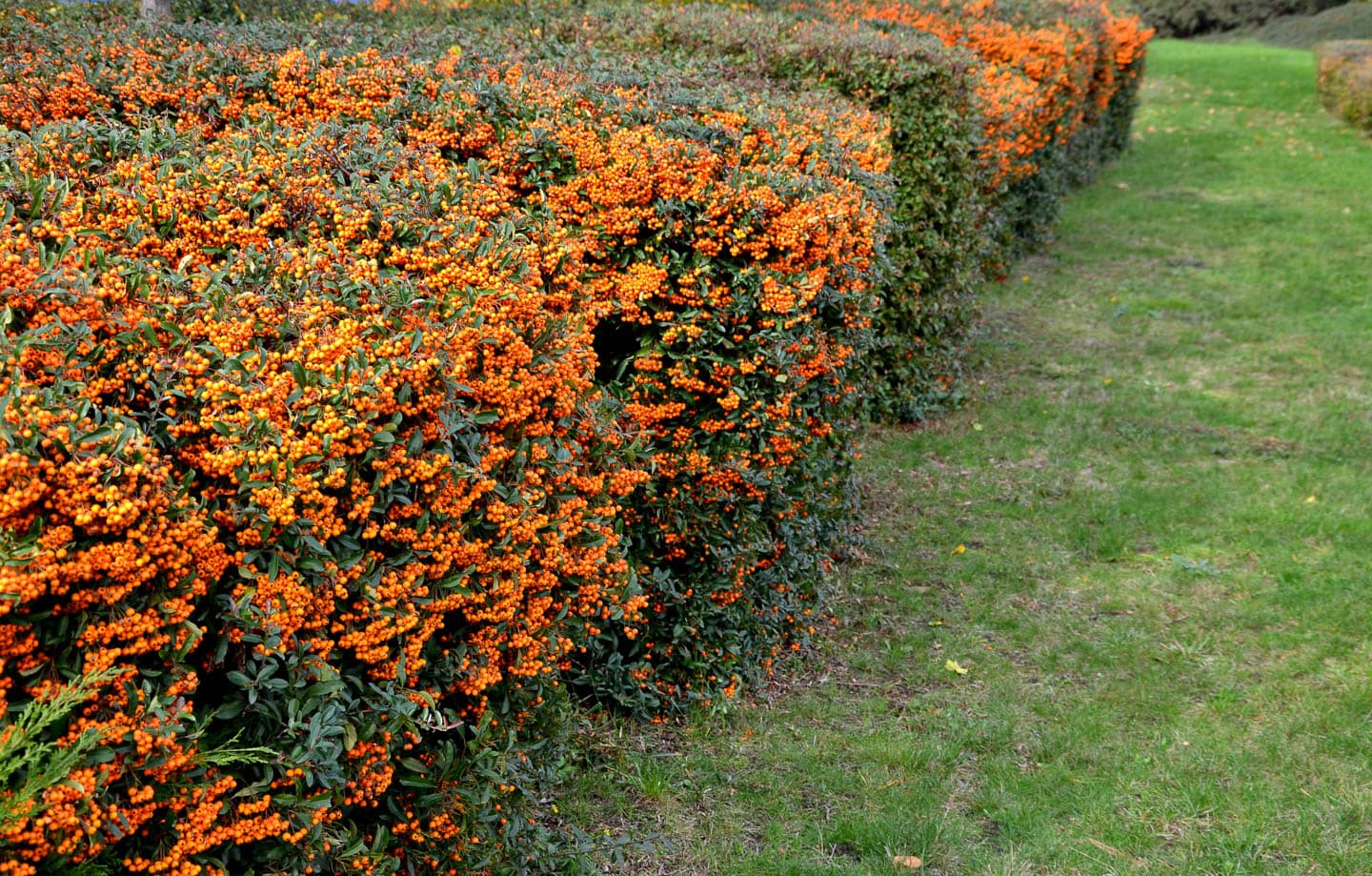
Botanical Name: Pyracantha
Zones: 5 to 9
Light Requirements: Full sun to partial shade
Bloom Time: Foliage only
Height: 6 to 18 feet tall
Spread: 6 to 18 feet wide
Growth Rate: Up to 2 feet each year, mature in 3 to 9 years
Pest Resistance: Resistant to most pests
Firethorn is a unique shrub that features densely packed dark-green serrated leaves which provide plenty of coverage.
Since it is capable of spreading quite wide, it is an excellent choice for covering large areas.
Characterized by its clusters of orange berry-like fruits, these ‘pomes’ are edible and safe for consumption for animals and people alike.
Despite this, few animals show interest in eating the leaves or branches of the Firethorn, likely due to their rose-like thorns.
8 | Clumping Bamboo
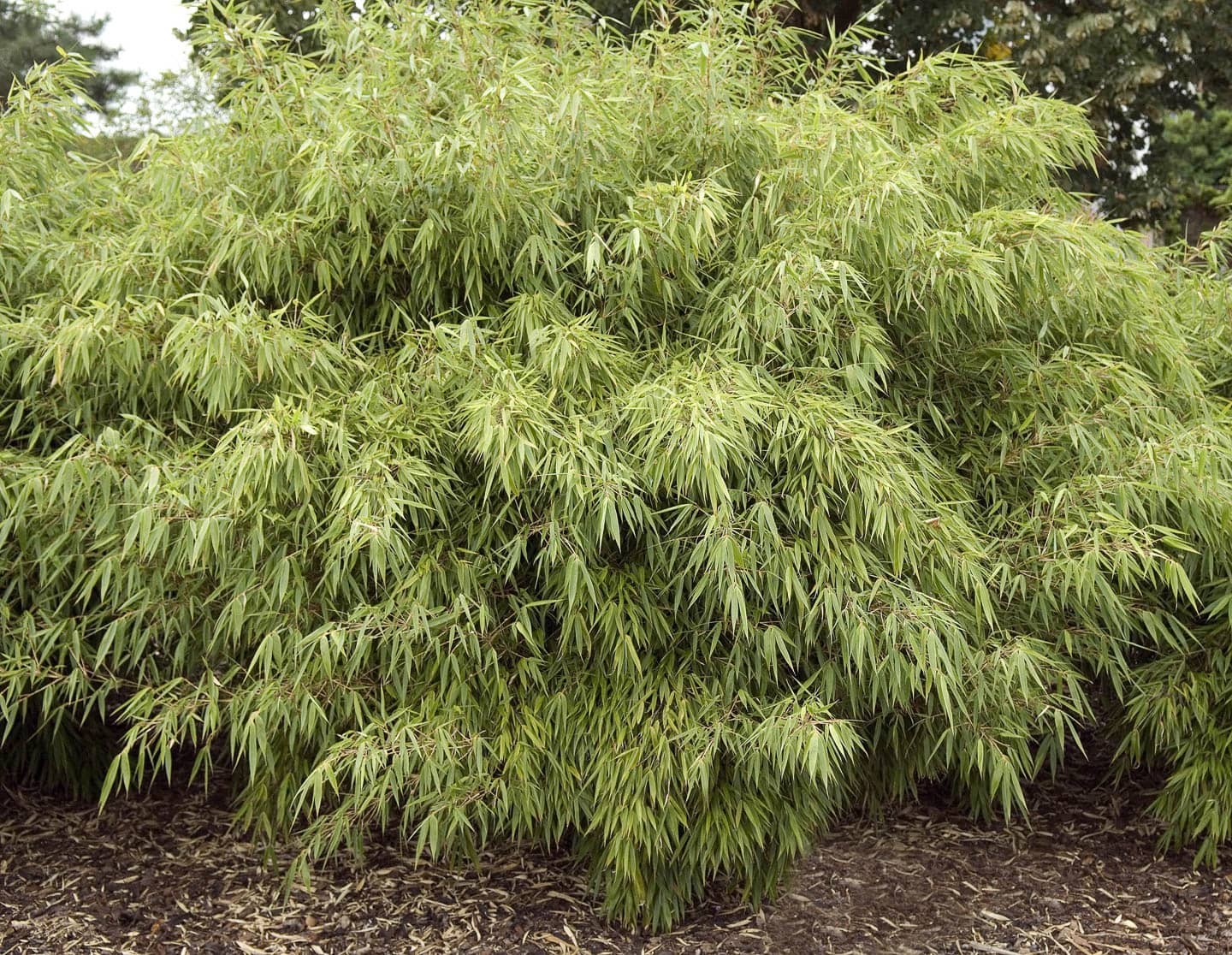
Botanical Name: Fargesia
Zones: 5 to 9
Light Requirements: Partial shade to full shade (especially in warmer zones)
Bloom Time: Foliage only
Height: 8 to 15 feet tall
Spread: 6 to 8 feet wide
Growth Rate: 2 to 12 inches per year, full maturity in 10 to12 years
Pest Resistance: Resistant to deer and most other pests
If you have heard of bamboo taking over backyards and growing to 50 feet or more, don’t worry – that won’t happen with this type of bamboo!
Clumping Bamboo has a non-invasive root system that won’t migrate throughout your garden, and it is ideal for reducing noise while also offering plenty of privacy.
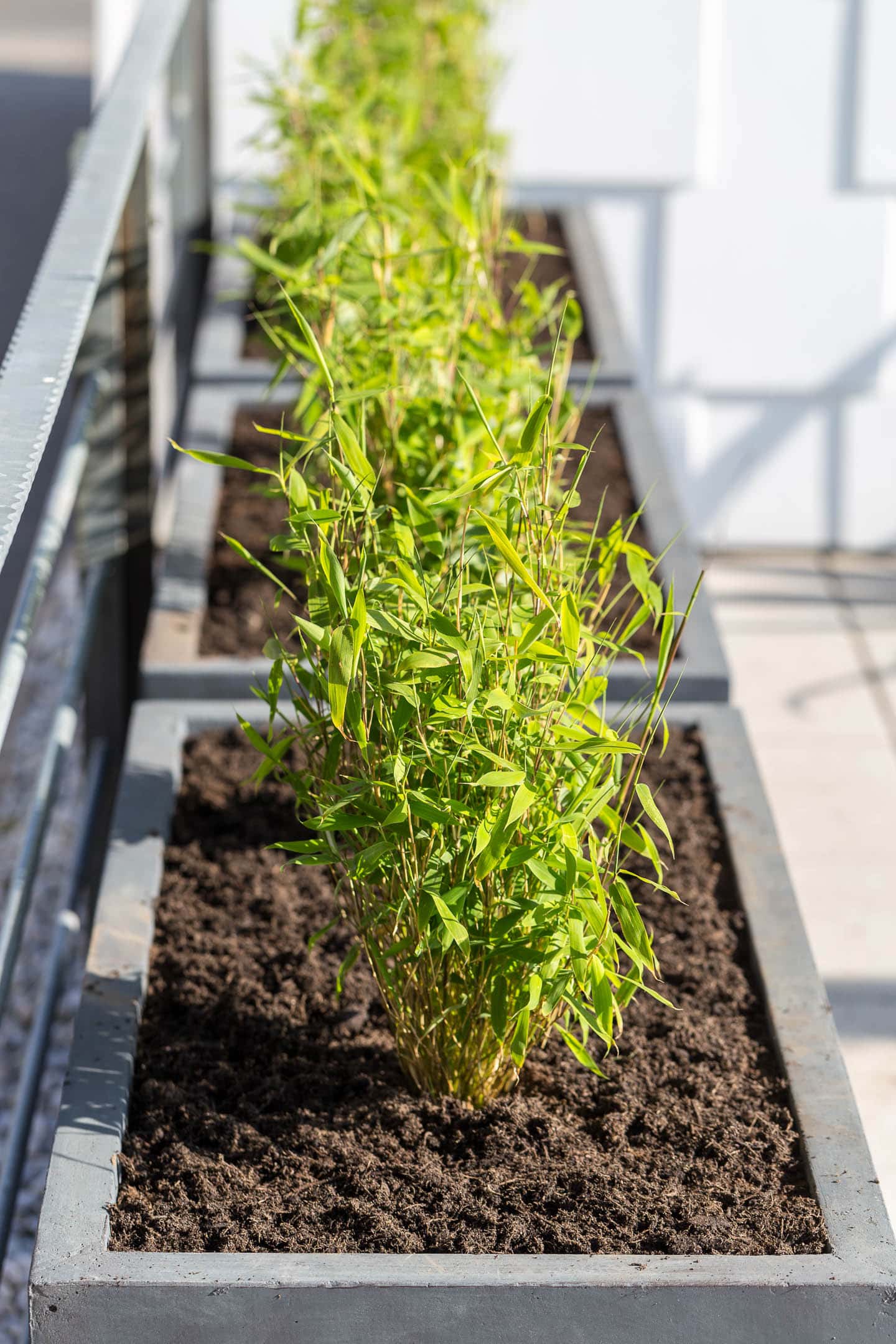
To reduce growth while still enjoying plenty of coverage, consider planting it in large pots.
9 | Holly

Botanical Name: Ilex
Zone: 5 to 9
Light: Full sun to partial shade
Bloom Time: Spring
Bloom Color: White
Height: 2 to 50 feet tall (depending on the variety)
Spread: 3 to 20 feet wide
Growth Rate: 6 inches per year; mature in 6 to 10 years
Pest Resistance: Resistant to deer
Holly is a broadleaved, evergreen shrub that is easy to grow and care for, and produces bright red berries in fall and winter that are often used as Christmas decorations.
It is deer resistant, drought tolerant, and can grow in many climates.
There are also many different varieties available, with different growth rates, zones and sizes so you should be able to find one to meet your needs.
10 | Leyland Cypress
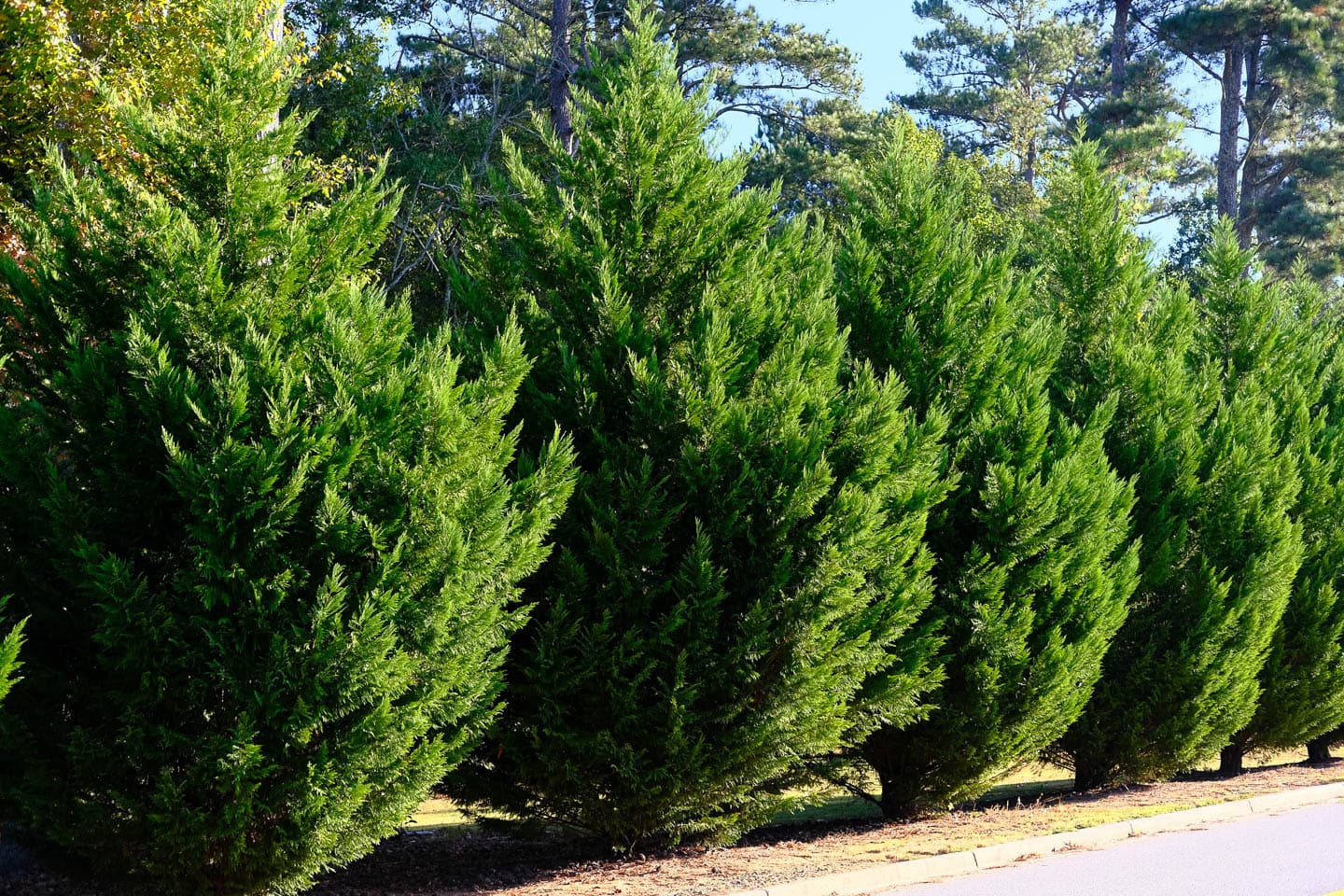
Botanical Name: Cupressocyparis x leylandii
Zones: 6 to 10
Light requirements: Full sun
Bloom Time: Foliage only
Height: 60 to 70 feet tall
Spread: 15 to 25 feet wide
Growth Rate: 4 feet per year; full maturity in 4 to 7 years
Pest Resistance: Resistant to deer
The Leyland cypress is a hybrid coniferous evergreen tree with feathery, soft foliage that is known for its rapid growth rate and ability to thrive in a wide array of environments.
This particular tree has the potential to grow 3 to 5 feet per year. Its considerable height and spread make it useful for windbreaks, hedgerows, or property boundary lines if you have enough space.
The Leyland cypress is remarkably tolerant of most types of soil including acidic, alkaline, loamy, moist, rich, sandy, well-drained, and clay, even thriving in high salt environments.
For best growth, plant it in full sun (where it will get at least 6 hours of sunlight) and prune annually to maintain its size and shape.
The tree is largely pest-free and provides cover for songbirds in the winter, who enjoy resting in its softer needles.
11 | Southern Magnolia
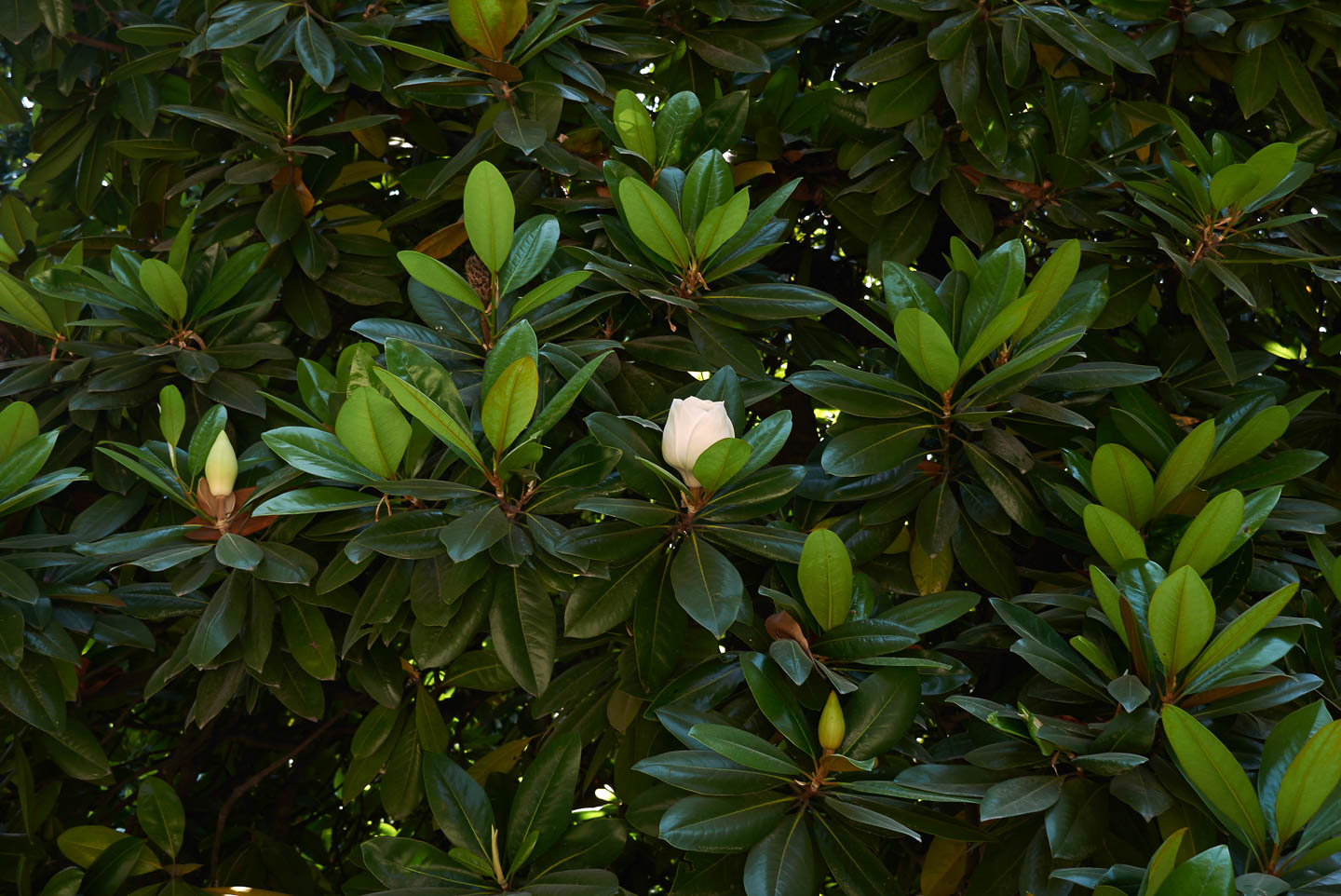
Botanical name: Magnolia grandiflora
Zone: 6 to 10
Light: Full sun to partial shade
Bloom Time: Spring
Bloom Color: White
Height: 60 to 80 feet tall
Spread: 30 to 50 feet wide
Growth Rate: 1 to 2 feet per year; full maturity in 30 to 80 years
Pest Resistance: Resistant to deer
Magnolia trees come in a variety of shapes and sizes, some deciduous and some evergreen. One of the most common types of evergreen magnolias for a privacy hedge is the southern magnolia.
With its striking dark green leaves and lovely white blossoms, the southern magnolia is a North American native plant that makes a beautiful backdrop to your garden and provides shelter for many birds.
This magnificent tree is remarkably low maintenance, requiring little to no pruning and thriving in moist, well-drained, acidic soil.
It does get quite large so plant it in an area where it has room to spread out.
12 | Red Tip Photinia
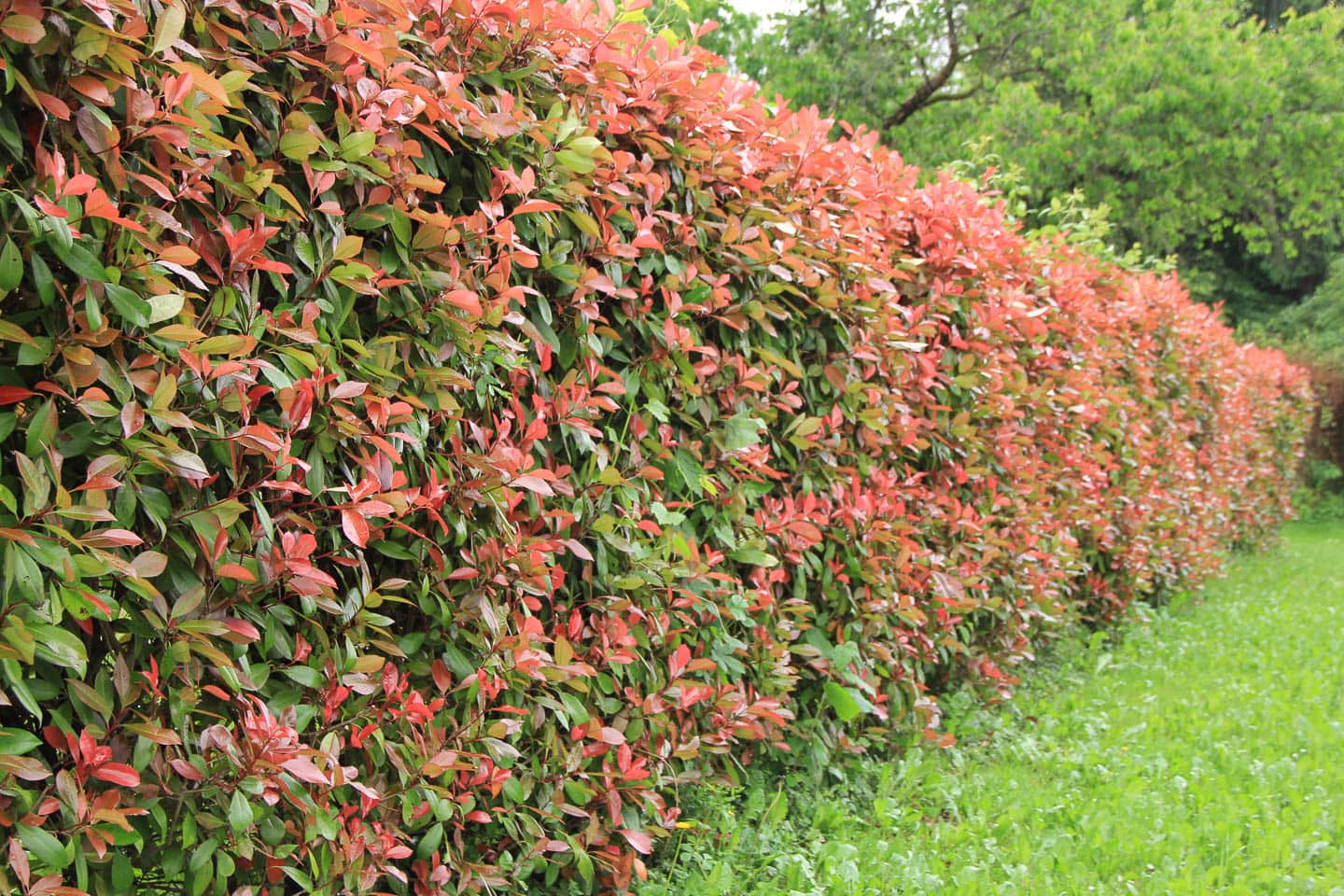
Botanical Name: Photinia x fraseri
Zones: 7 to 9
Light Requirements: Full sun to partial shade
Bloom Time: Spring
Bloom Color: White
Height: 10 to 15 feet tall
Spread: 10 to 15 feet wide
Growth Rate: 1 to 3 feet each year, full maturity in 4 to 10 years
Pest Resistance: Toxic to most animals
Photinia is a tall shrub which features bright red leaves in the early spring that transform to a dark green as they mature.
While these shrubs do flower, the flowers have an unpleasant smell, so you may want to trim them off just as they appear.
However, if you don’t mind the smell, the blooms appear in tight white clusters that contrast beautifully against the fire-red of the leaves.
13 | Camellia
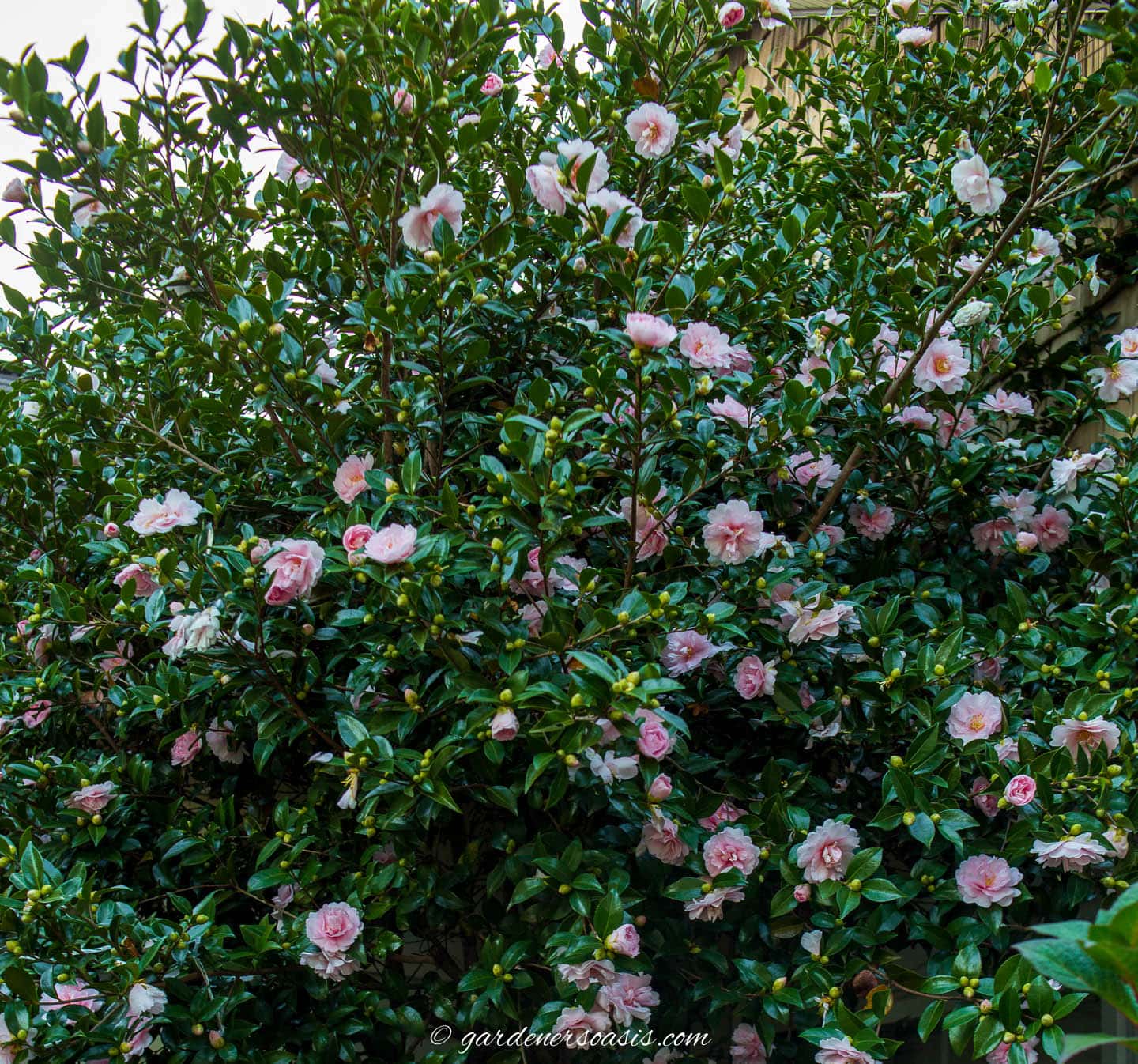
Botanical name: Camellia
Zone: 7 to 9
Light: Full sun to partial shade
Bloom Time: Fall to early spring (depending on variety)
Bloom Color: White, red or pink
Height: 2 to 18 feet tall
Spread: 5 to 7 feet wide
Growth Rate: 6 to 10 inches per year; full maturity in 10 to 20 years
Pest Resistance: Susceptible to scale insects
Camellia is a lovely evergreen shrub that features dark green foliage with vibrant flowers that are about three to four inches in size.
Depending on the variety, they can bloom anywhere from early fall to early spring. Which makes them extra special, since they bring color to the garden at a time when not much else does. The blossoms range in color from white to red to light pink.
They are low maintenance plants, growing well in moist, acidic, well-drained soil.
The only notable pests attracted by camellias are scale insects, though these can be treated or even prevented quite easily with the proper care.
14 | Fringe flower
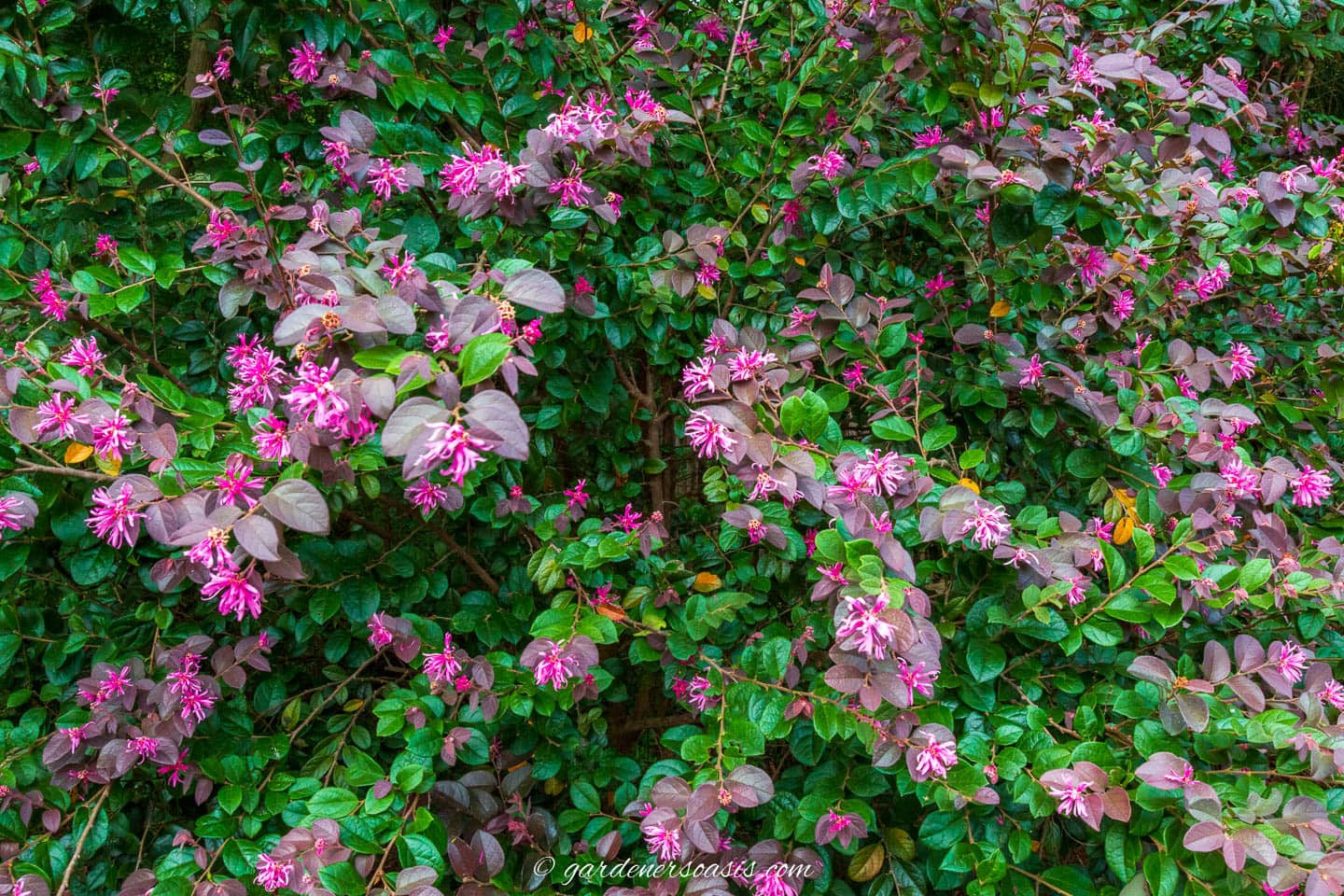
Botanical name: Loropetalum chinense
Zone: 7 to 10 (depending on the variety)
Light: Full sun to partial shade
Bloom Time: Spring
Bloom Color: Pink
Height: 6 to 10 feet tall
Spread: 6 to 10 feet wide
Growth Rate: 10 to 15 inches per year; full maturity in 7 to 11 years
Pest Resistance: Resistant to deer
Part of the witch-hazel family, the fringe flower is an evergreen shrub known for its beautiful flowers.
They make excellent border or screen plants and can be pruned as much as necessary after they finish blooming in the spring.
However, it’s not just the flowers that make the fringe flower stand out. They also come in a variety of leaf colors including bright red and burgundy which add interest to your garden border even when they aren't blooming.
The fringe flower thrives in moist, well-drained, acidic soil and has no notable issues with pests.
Like many other evergreen shrub types, fringe flower shrubs can be trimmed to prevent them from out-growing their allotted space.
15 | Kohuhu
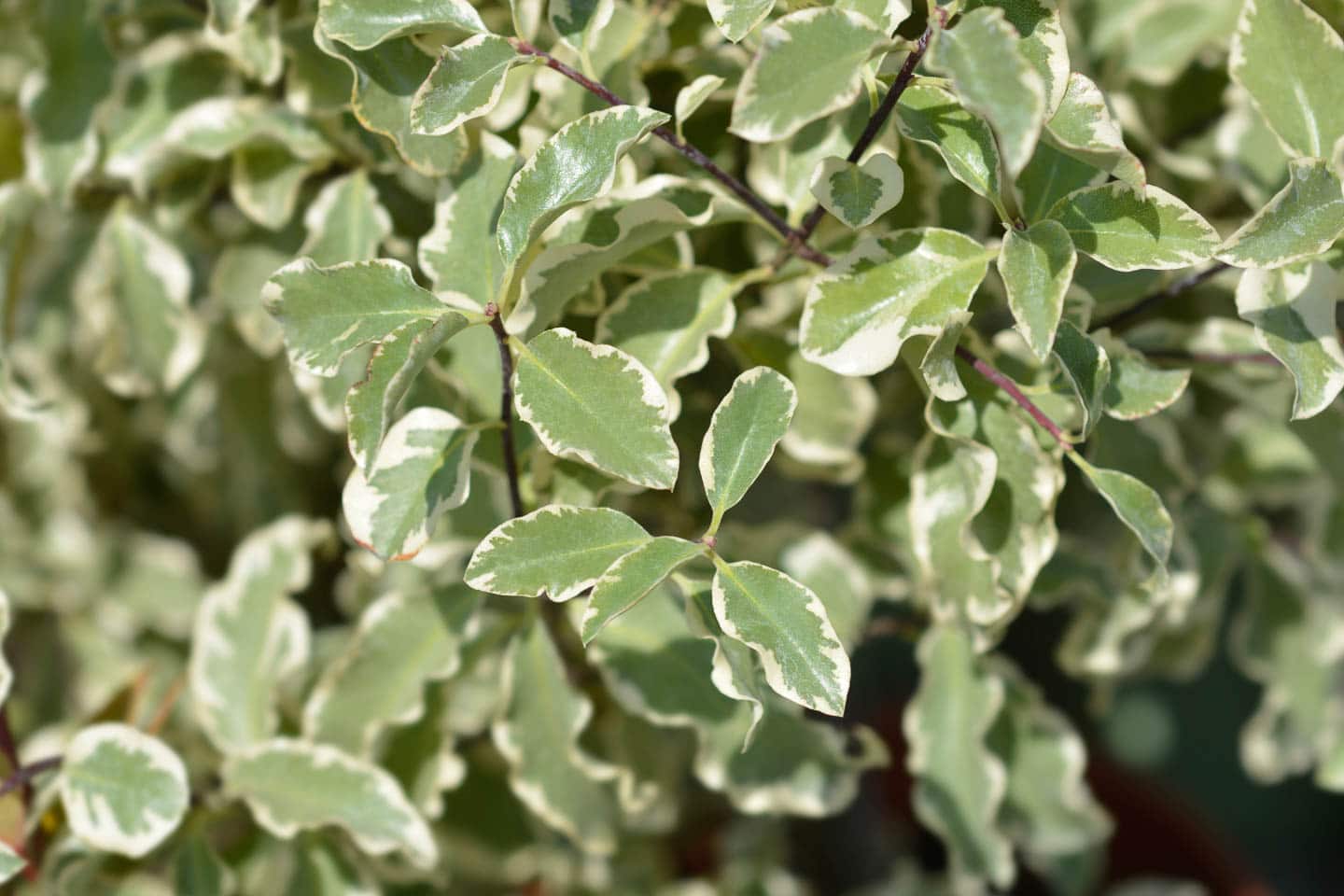
Botanical Name: Pittosporum tenuifolium
Zone: 7 to 11 (depending on the variety)
Light requirements: Full sun to part shade
Bloom Time: Spring
Bloom Color: Purple
Height: 10 to 12 feet tall
Spread: 6 to 8 feet wide
Growth Rate: 2 to 3 feet per year; mature in 2 to 5 years
Pest Resistance: Susceptible to mites and aphids
Pittosporum is a fast growing evergreen shrub that makes a great privacy hedge in warmer areas (including Florida).
It thrives in fertile, moist, well-drained soils and does not require a lot of maintenance. Including no need for annual pruning to keep its shape or size at the desired dimensions.
The plant blooms in late spring to early summer, producing small purple flowers that may be hard to see, but you can certainly smell their pleasant honey-like scent in the air.
It is generally not prone to attract pests, with aphids and glasshouse red spider mites being the main source of any problems.
16 | European Fan Palm
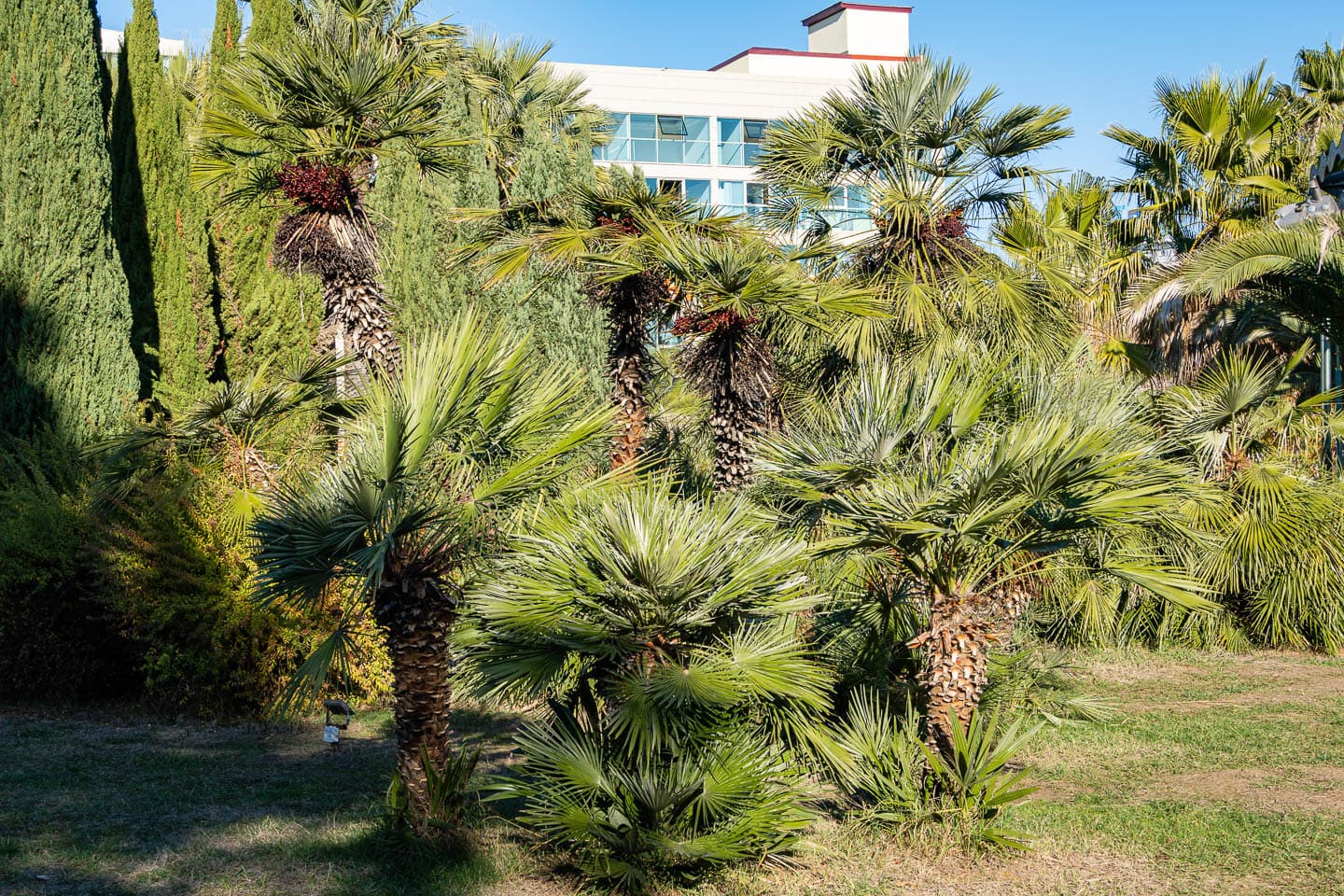
Botanical Name: Chamaerops humilis
Zones: 8 to 11
Light Requirements: Full sun
Bloom Time: Foliage only
Height: 8 to 15 feet tall
Spread: 6 to10 feet wide
Growth Rate: 5 inches per year, full maturity in 15 years
Pest Resistance: Resistant to most pests
If you live in the southern areas of Texas, Louisiana, or Florida, you may be able to grow Fan Palms in your yard!
Fan palms are an evergreen native to areas of the Mediterranean but grow beautifully in hot, humid climates.
Relatively short as compared to other varieties of palm and featuring broad, 2-foot long leaf segments, palm fans make the perfect natural privacy screen.
Because of their thick, fibrous, and pointy leaves, few animals show interest in this plant variety, making it a good choice for people in areas with large deer populations.
Frequently asked questions
What is the fastest growing evergreen hedge for privacy?
‘Green Giant' Aborvitae and Leyland Cypress both grow very quickly (between 3 and 5 feet per year) and can reach a tall privacy hedge height in 2 to 3 years.
What is the most hardy evergreen?
Thuja occidentalis and Canadian Hemlock are both cold hardy evergreens that will survive in zone 3.
What is the best privacy hedge for warm climates (like Florida)?
European fan palms and Pittosporum tenuifolium will both grow in zones 9 to 11 making good privacy hedges for warm zones.
Other privacy ideas you might like
- Backyard privacy ideas for screening neighbors out
- How to build a decorative privacy screen
- How to build a custom wooden fence
Other shrubs you might like
Do you have other suggestions for our list of the best evergreen shrubs for a privacy hedge? Tell us in the section below.
This post was originally published on May 12, 2022 but was updated with new content on November 23, 2024.

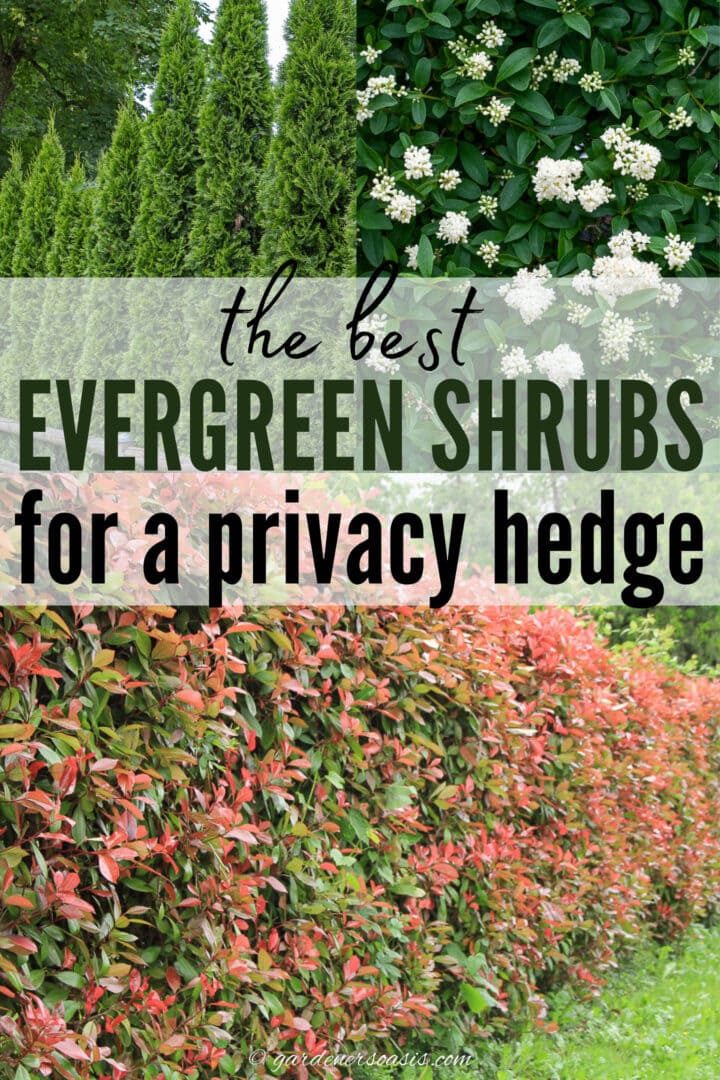

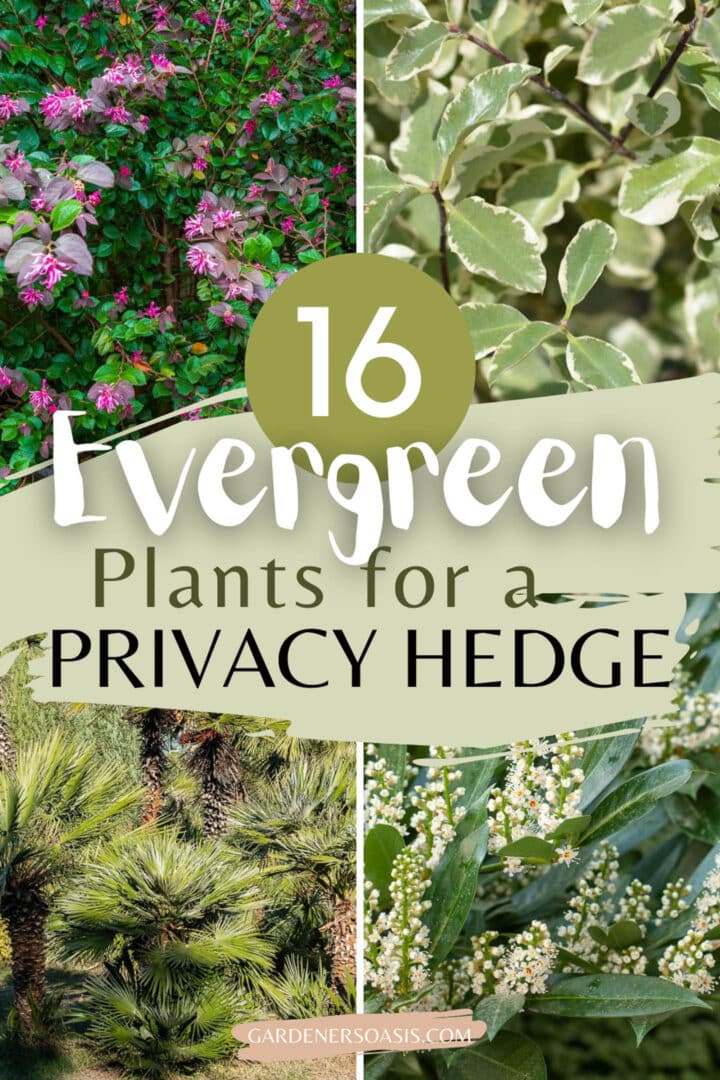
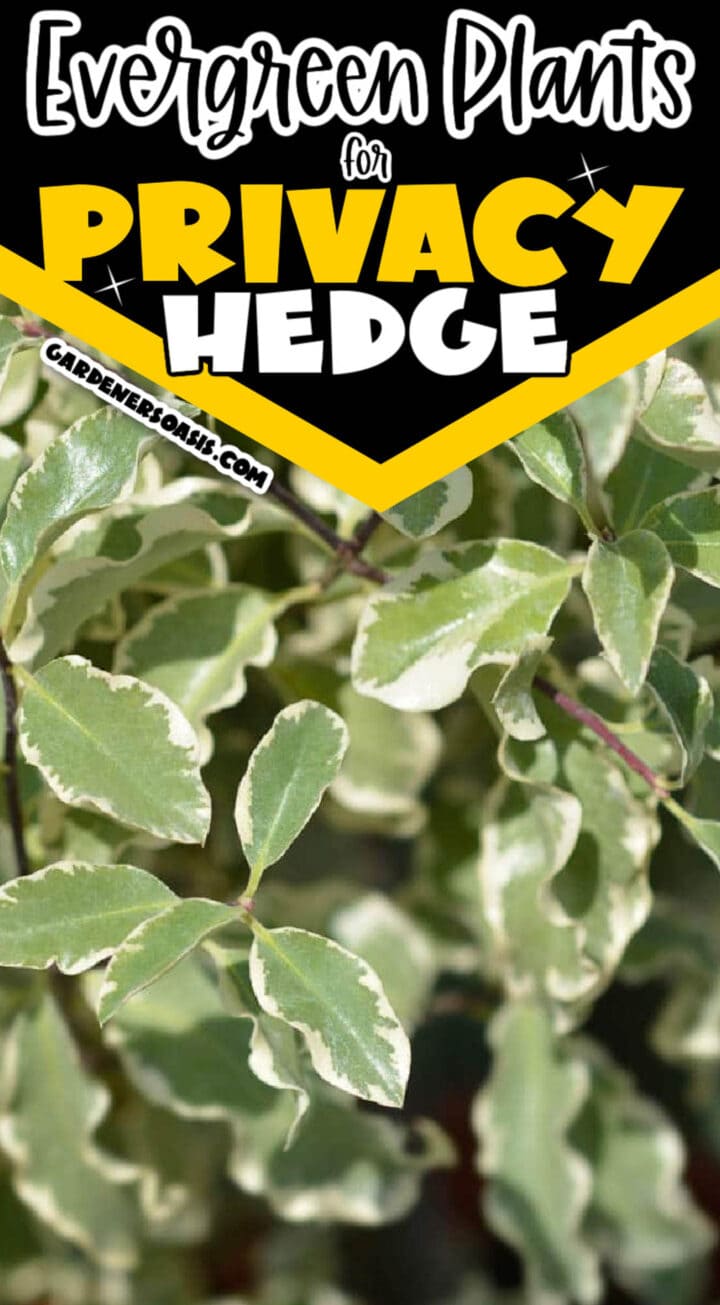
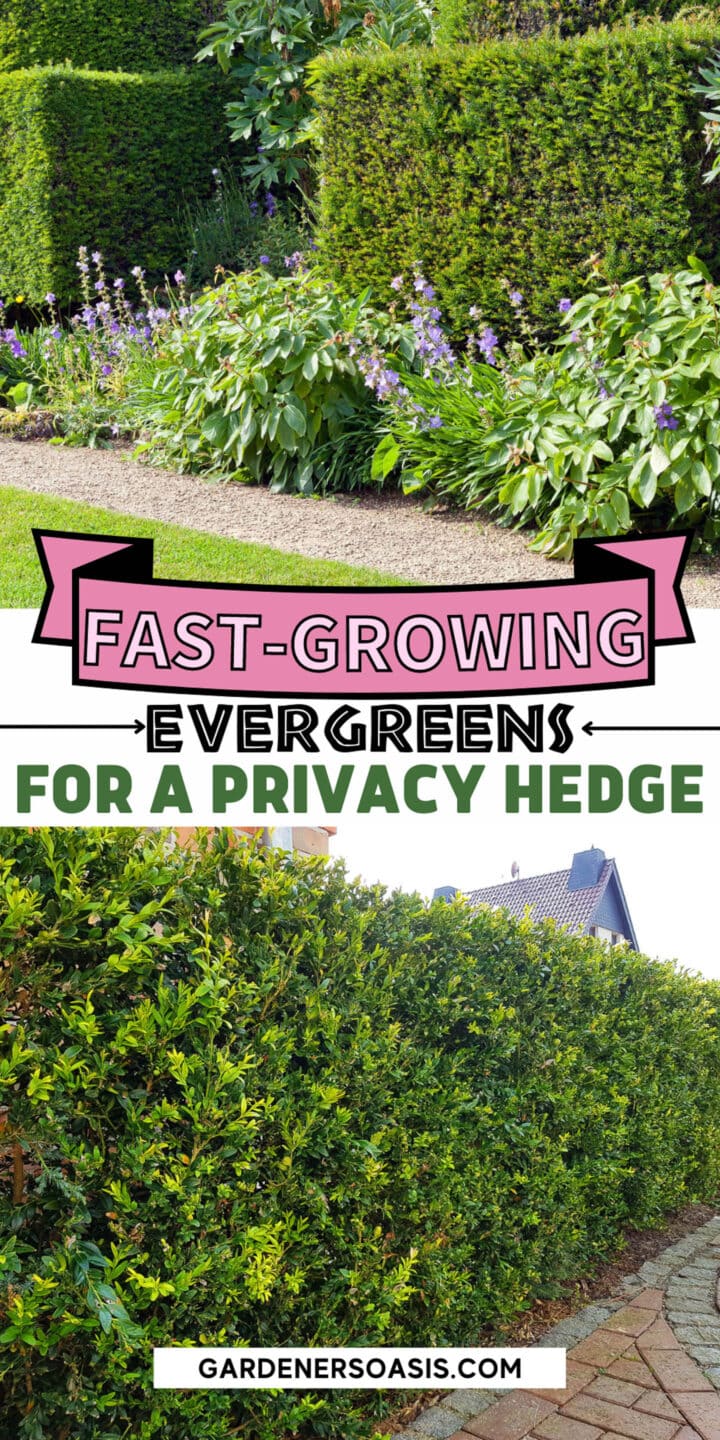
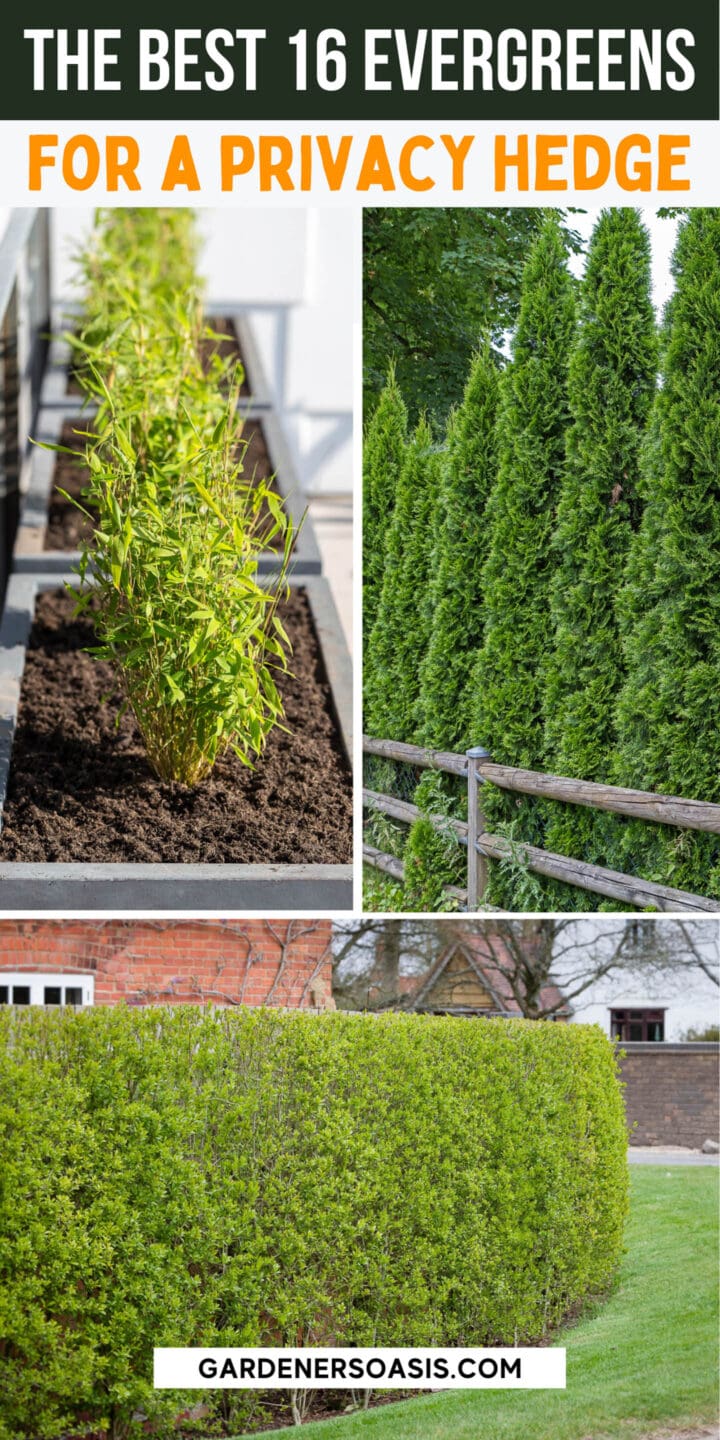
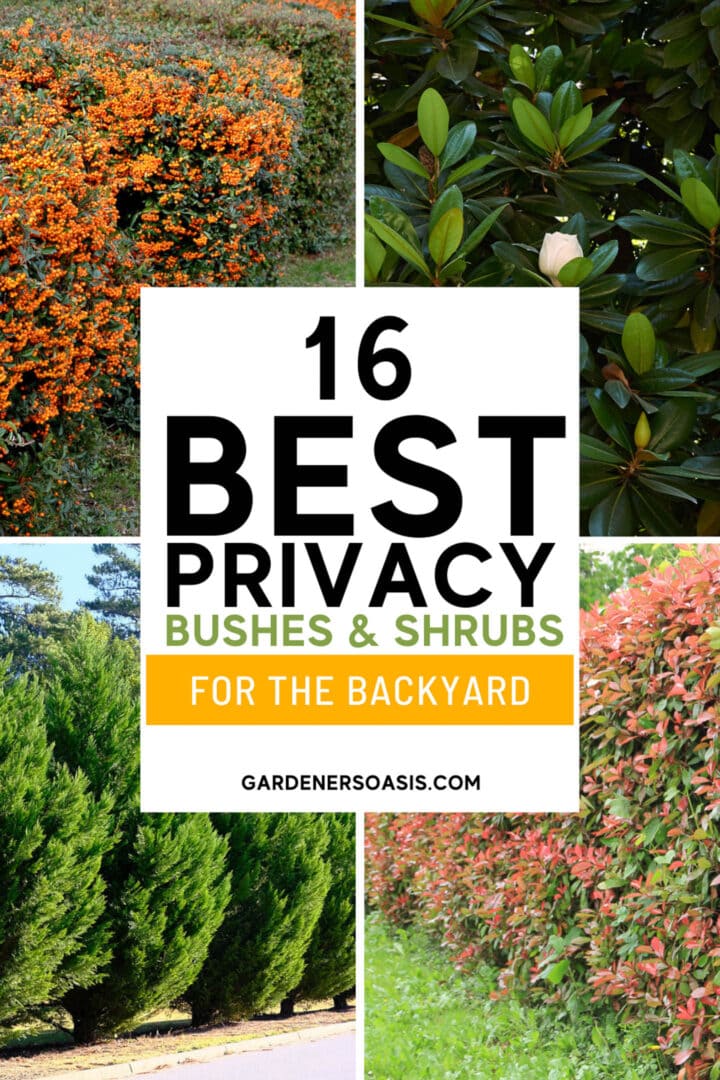
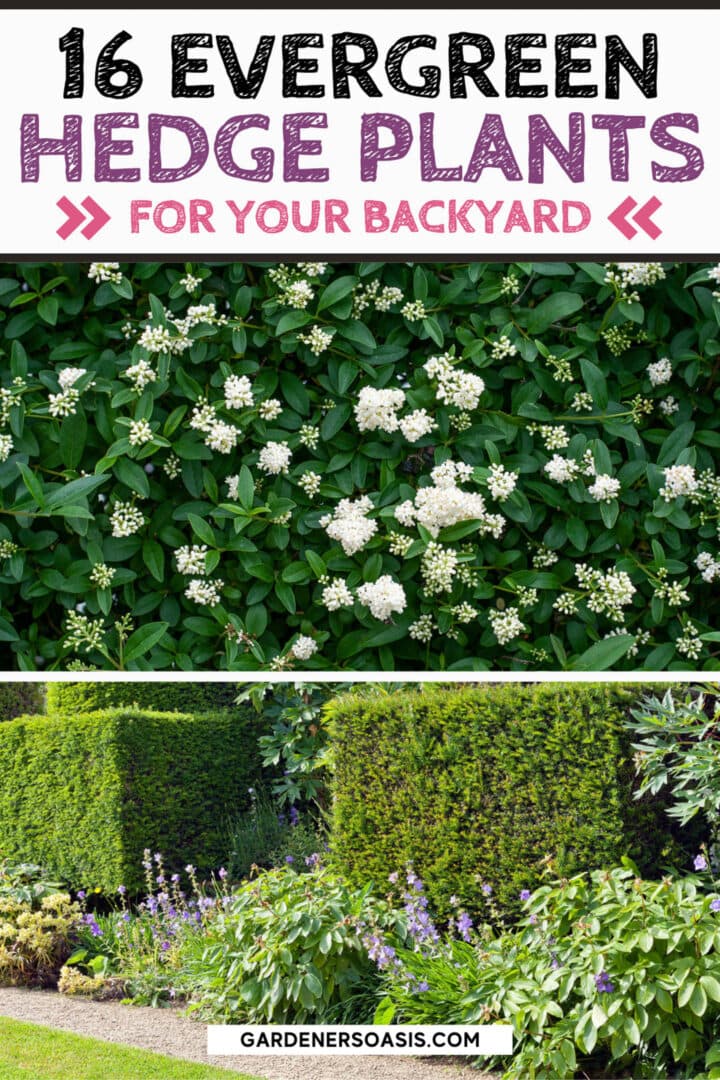

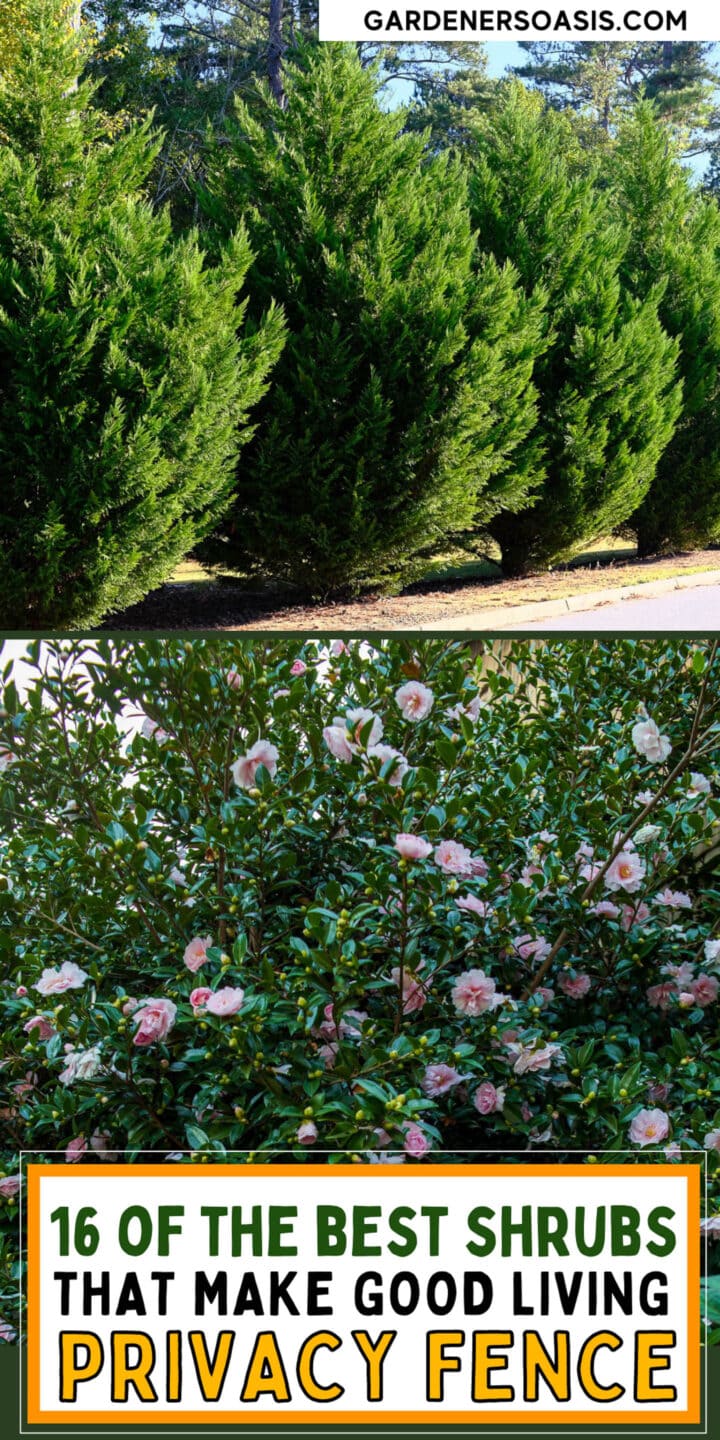

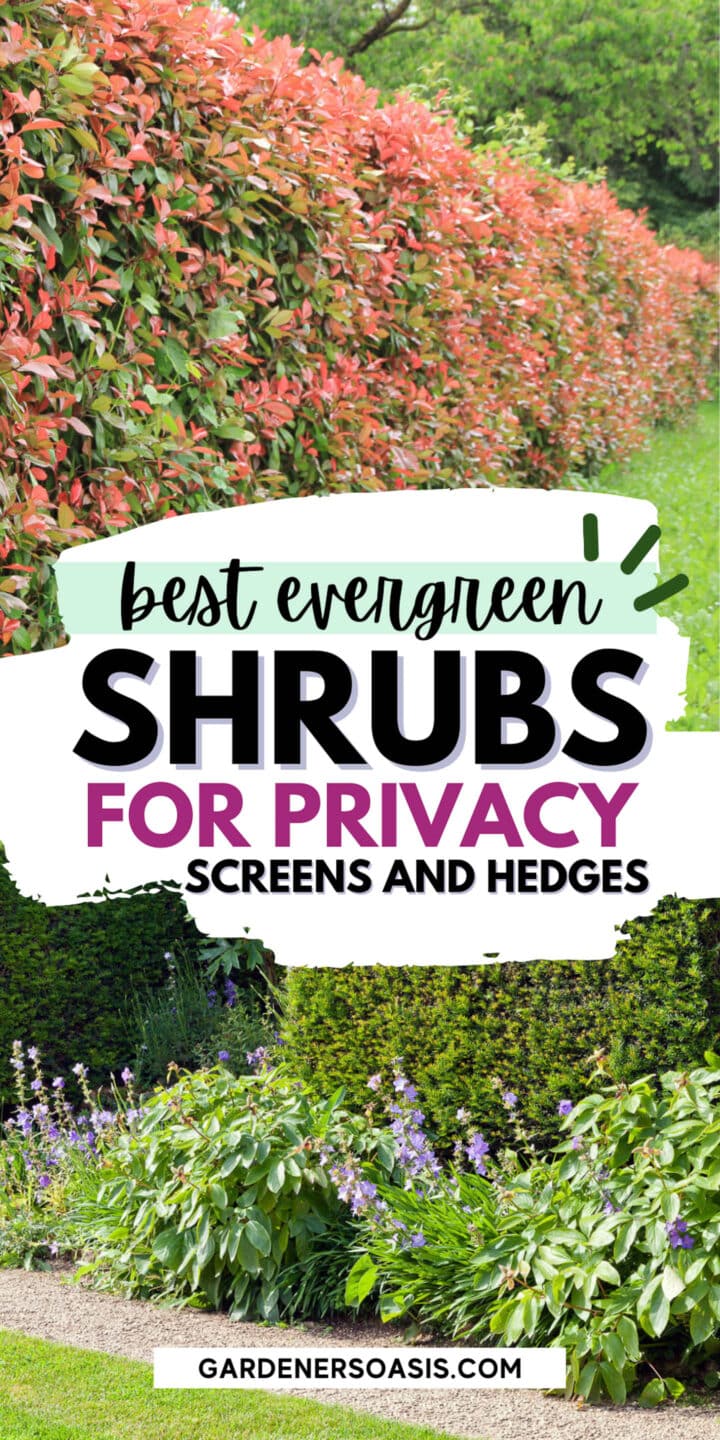
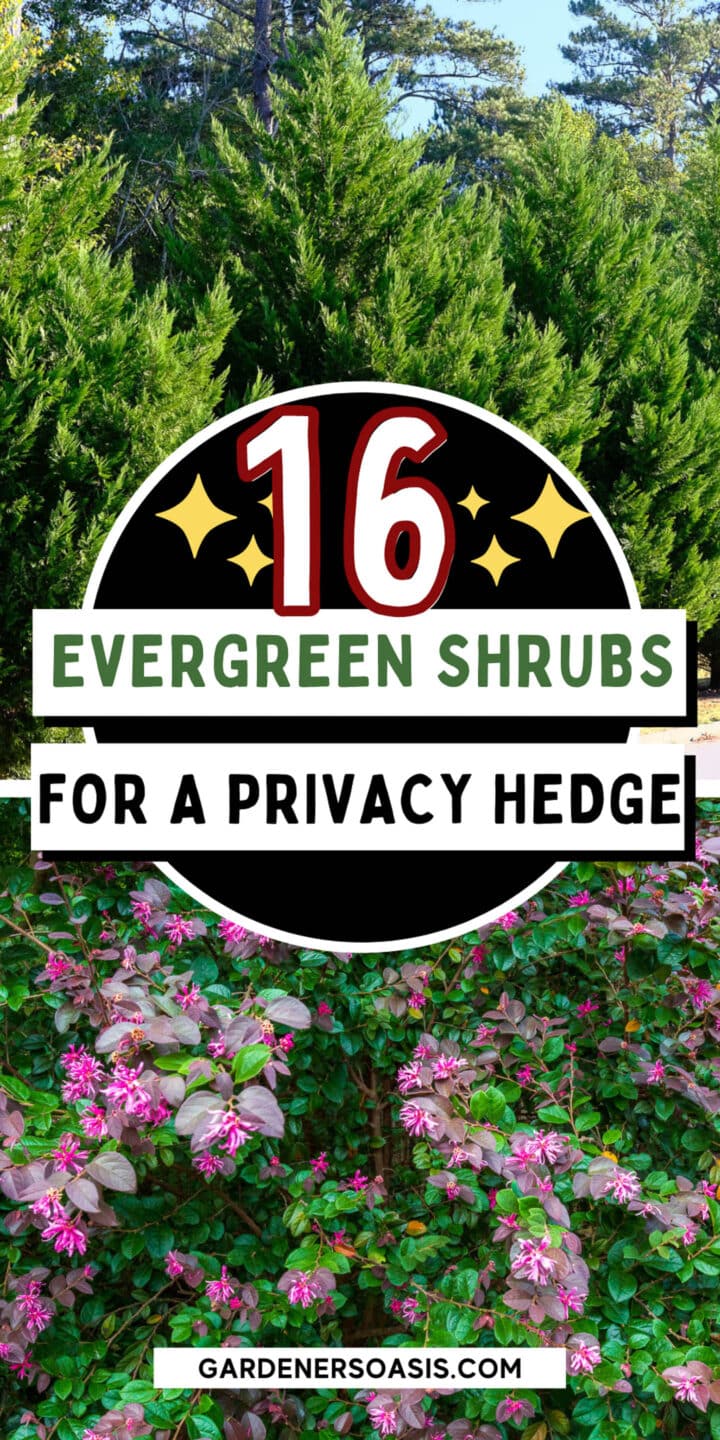

Hi Wanda,
Please remind your readers that they don’t want to just pick one. You have such an extensive list here, anyone can choose 2 or 3 shrubs and use them as a more natural barrier. It will look nice, with perhaps a longer blooming time and if a species specific pest comes to their area, they won’t all get attacked.
Thanks for the reminder, Lin! You’re right…planting a hedge with a few different types of bushes does look more interesting and natural looking.
Wonderful, informative article. WILL keep for Future reference and pass it along to My daughters. THANK you!!😀
Thanks, Heather! I’m happy you found it helpful!